We brought our child to India for two weeks when they were 2.5 years old. Over 14 days, we traveled to the Golden Triangle cities of Delhi, Jaipur and Agra, plus we spent a few days in Udaipur. If you’ve ever thought about going to India with kids, this post is for you. It combines everything we learned from that experience, from dreaming and planning to actually going and then reflecting back on it. Follow along as we share our personal experience but also pack in every single tip, note and lesson learned.
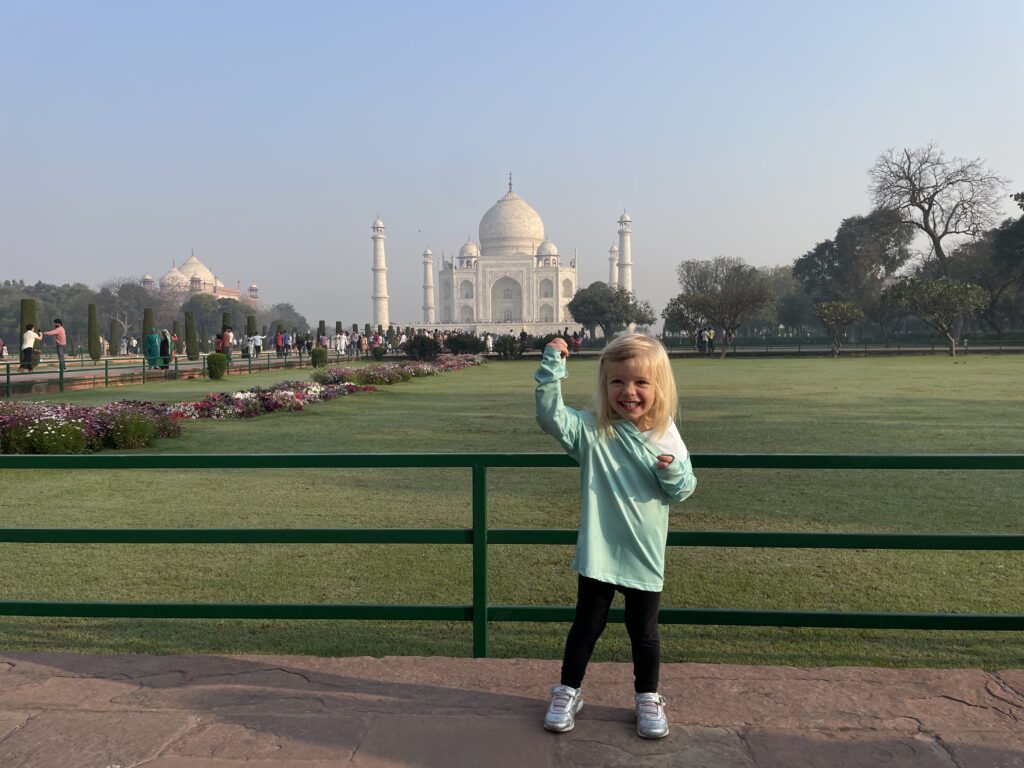
In This Post
We cover a lot in this post, so we broke it up into three main parts. Here’s what you can expect to find.
- Part 1: Why India This section explores why you might choose to go to India, including what it’s like being there with kids.
- Part 2: Plan Your Trip Next, we dive into the nitty gritty details like what vaccines your kids need and how to get around with them safely.
- Part 3: Review & Reflection Finally, we look back on this trip and discuss what we thought, what our kid thought and whether we’re glad we did it.
Disclaimer
We have traveled a lot (almost 50 countries), we have lived in major cities most of our life, and our toddler has traveled internationally before. These life experiences are absolutely not required to go to India with kids, but it certainly influenced our experience. This is just something to keep in mind when you consider our reviews, recommendations and feedback.
Part 1: Why India?
If you’re in the dreaming and pre-planning phase, this section is for you. We’ll cover why you might want to bring a kid to India, but also what it’s like to be there.
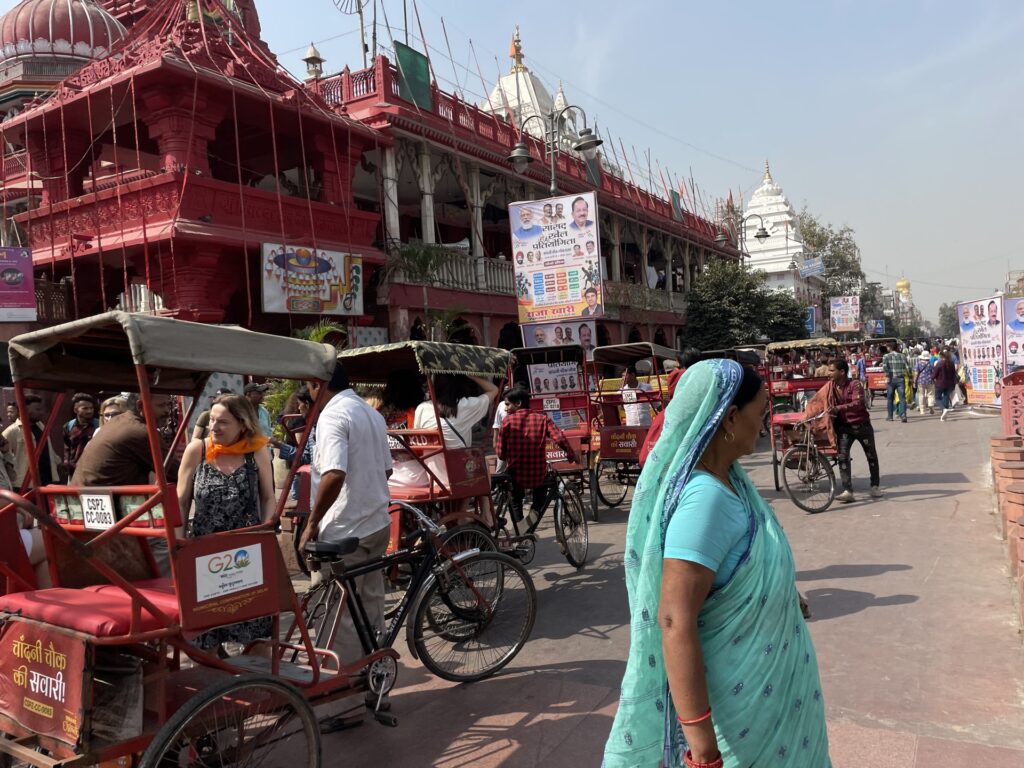
Why We Chose to Go to India With a 2-Year-Old
My husband rightly just corrected this header, because the decision to go to India was almost entirely his.
I was personally never excited about the idea of India. Maybe it was the viral images of the overcrowded trains or my one friend who didn’t love her experience, but India was never high on my list. I think my hesitancy about India was partly why I needed to go. At the heart of it, I think India seemed difficult and I was masking that by convincing myself that I didn’t want or need to go.
Then there’s my husband, who actually convinced us all to book this trip. He is the type of travel planner who needs to be hit with a spark of inspiration. Heck, it only took each of our bosses quitting and a couple beers one night to suggest we take a year off to travel the world, and we all know how that turned out. (Spoiler alert: We did it.)
There were a few sparks that got us to India. One was Holi. This colorful spring festival celebrated around India had found its way onto a forgotten “Bucket List” note on Kenny’s phone. It turned out that Holi actually fell right in the middle of the dates we were looking at for a potential trip.
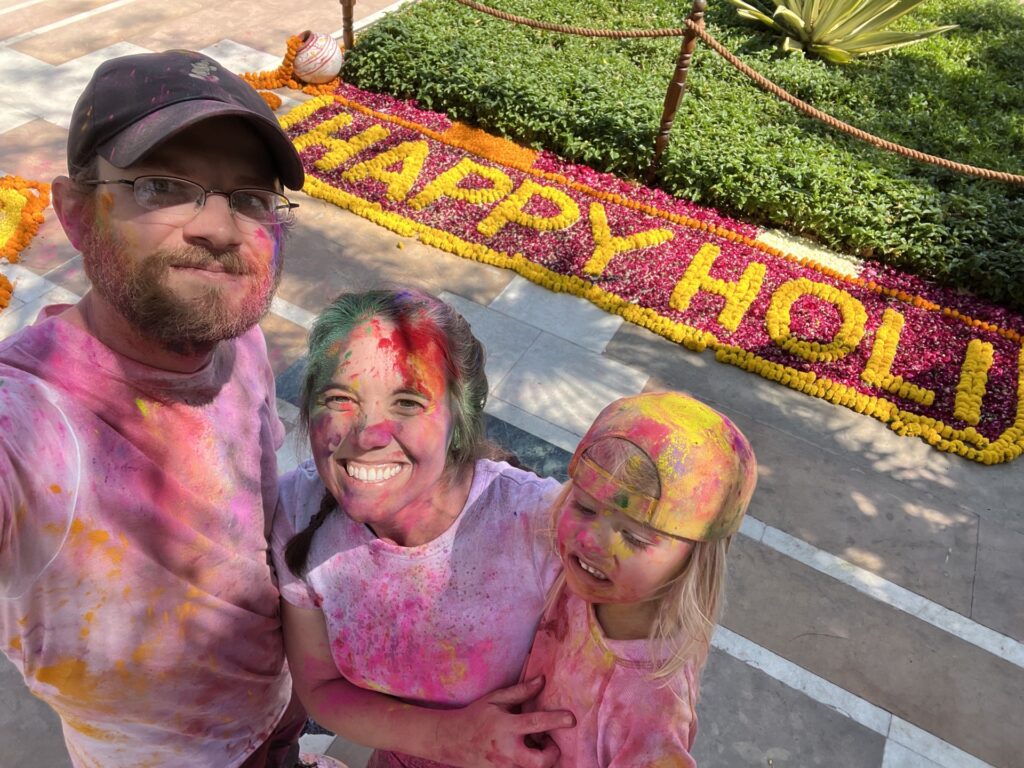
The second thing was Qatar Qsuites, a product we’d dreamed of flying for years. How is that related at all to India? Well, we were never going to spend more than a few days in Doha, so we needed to pair that with a bigger trip in the region. India fit the bill perfectly.
Then there was the obvious appeal to India: the history, the architecture, the culture, the food. India is the second largest country by population and has one of the richest global histories in the world. The Taj Mahal alone is reason enough to go to India.
The last thing was less of a spark and more of our family travel strategy. I know some families feel strongly about saving travel and destinations for when kids are old enough to remember. We believe that there are so many more important reasons to travel than just simply to remember it. Personally, the only destinations we delay or “save” are places that we want to do a specific way at a certain age. (For example, we’re saving Thailand and so we can backpack it together as a family.) India was basically going to be the same trip whether we did it now or in 5 years.
We had a holiday, a fun flight, plenty of things to do, and no real reason to delay India. We had three weeks available to travel and it wasn’t during monsoon season. If not now, when? We booked the flight.
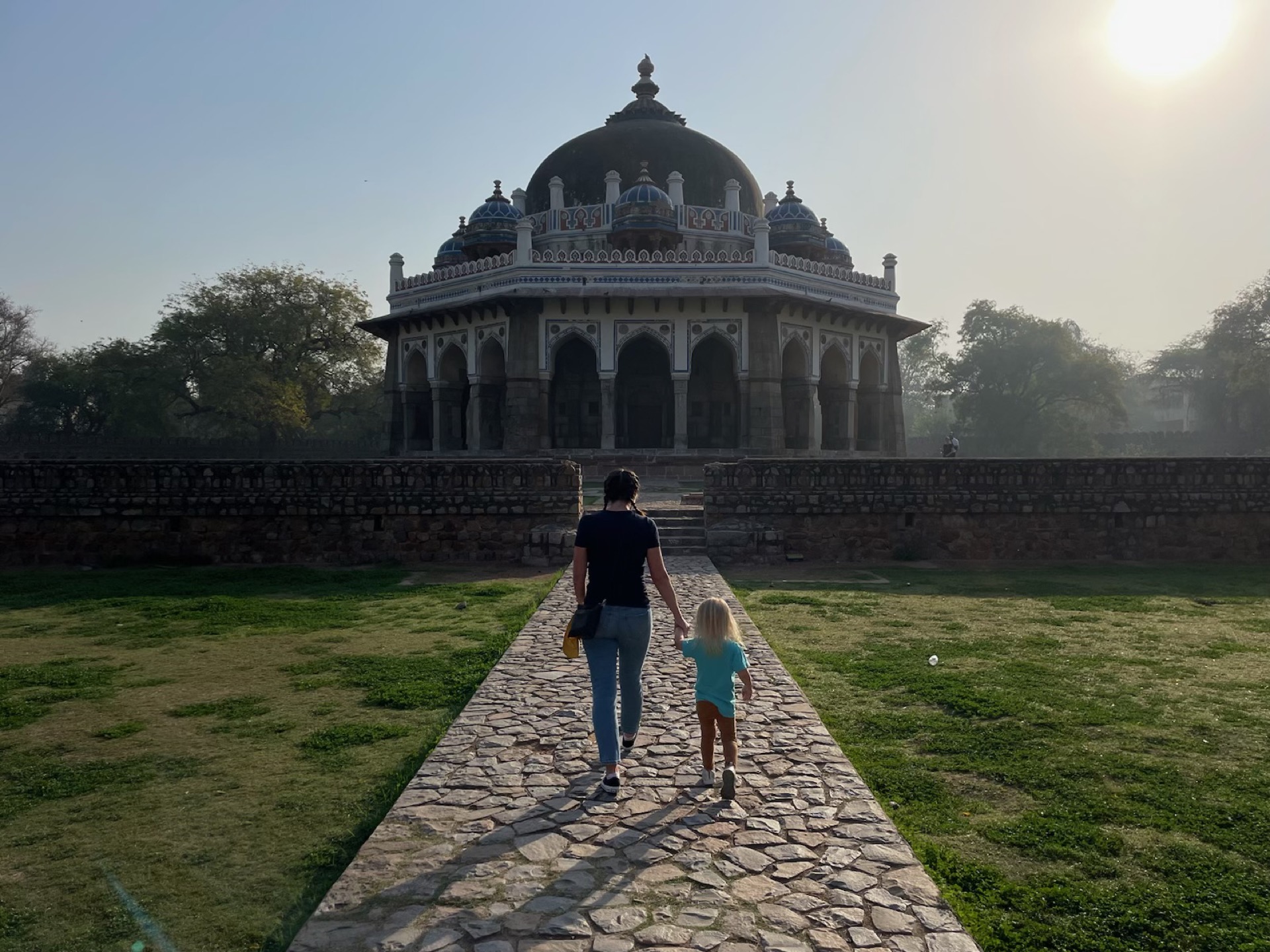
Is India Safe for Kids?
This is my least favorite topic to write about, so I want to get it out of the way right off the bat.
It’s not that safety isn’t important, but it’s highly personal and somewhat subjective. There is perceived safety versus statistical safety, and personal anecdotes only muddy that water. We all have different levels of situational awareness and intuitive safety habits that prepare us better or worse for certain scenarios. Plus, all parents have different thoughts on what is and is not safe for their kid(s).
Let’s get a few things out of the way first. Statistically, India does not fall very high on the safest countries in the world lists. (It’s worth noting that I’m writing from the US which also isn’t showing up on those lists.) The US State Department lists most of India as Level 2: Exercise Increased Caution. A lot of that has to do with civil unrest in specific disputed regions, but also because of violence against women and LGBTQ+ individuals.
That said, when traveling with kids, my best advice is to be prepared for the most common risks. In India, the most immediate and prevalent safety threat is actually traveler’s diarrhea. (The CDC predicts tourists have a +60% chance of getting traveler’s diarrhea compared to the <0.1% of reported crimes against foreigners.) Traveler’s diarrhea is caused by unsafe tap water and is particularly dangerous in kids who can quickly get dehydrated.
Should you or your children get sick, India does have (some) very good hospitals (accredited by the National Accreditation Board for Hospitals & Healthcare Providers). Just be sure to seek out a private hospital for the best care.

The next most common threat that tourists face in India is non-violent crimes like pickpocketing, petty theft, and scams. According to a report on crime in India, there were only 124 reported cases of crime against tourists in 2021 out of 7 million total visitors. (This is the math that drove the above <0.01% stat.)
Now, those numbers are certainly higher as most petty theft goes unreported, but these crimes are generally easy to protect yourself from. Don’t keep your phone in your back pocket. Keep your valuables secured in zipped, cross-body bags. Don’t carry all your cash and cards on you. Etc.
If you’re concerned about safety, I’d highly recommend doing some further reading from respectable sites that breakdown the specific risks for foreign traveler’s specifically. (I really like this article.) I would avoid fear mongering sites that focus on specific, personal stories. This is more likely to scare you than to actually empower you to visit India safely.
As a parent, I am painfully aware that the world is a scary place. There’s a part of me that wants to wrap my baby in bubble wrap so they’ll never even feel the pain of a skinned knee. But a bigger part of wants to show them that most of the world is actually good. I want to teach them how to be responsible and careful, but not to leave in fear.
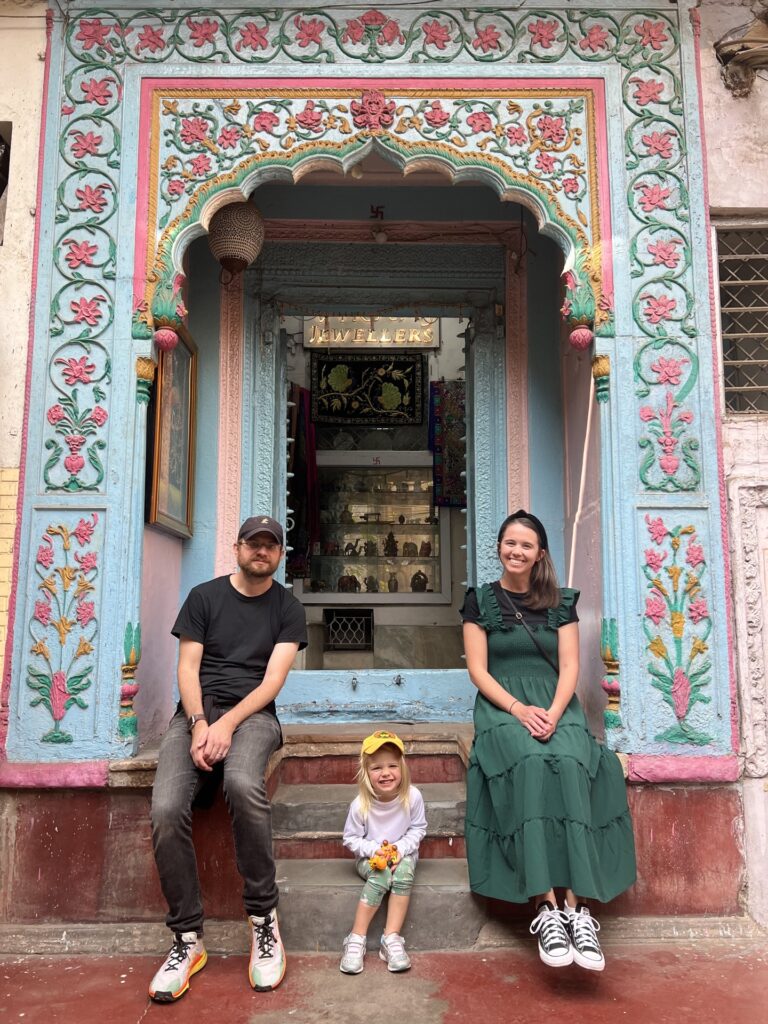
Is India good for kids?
Yes! Now let’s get on to the fun part!
As a general rule, my definition of a destination being “good for kids” is that kids can (and will want to) do all of best things that a place has to offer. Usually that means your itinerary will look roughly the same whether you’re going with kids or without kids.
India absolutely met that standard. We didn’t have to miss out on any experiences just because we were traveling with a kid, and we didn’t have to add “kid friendly attractions” just to ensure our kid had a fun time.
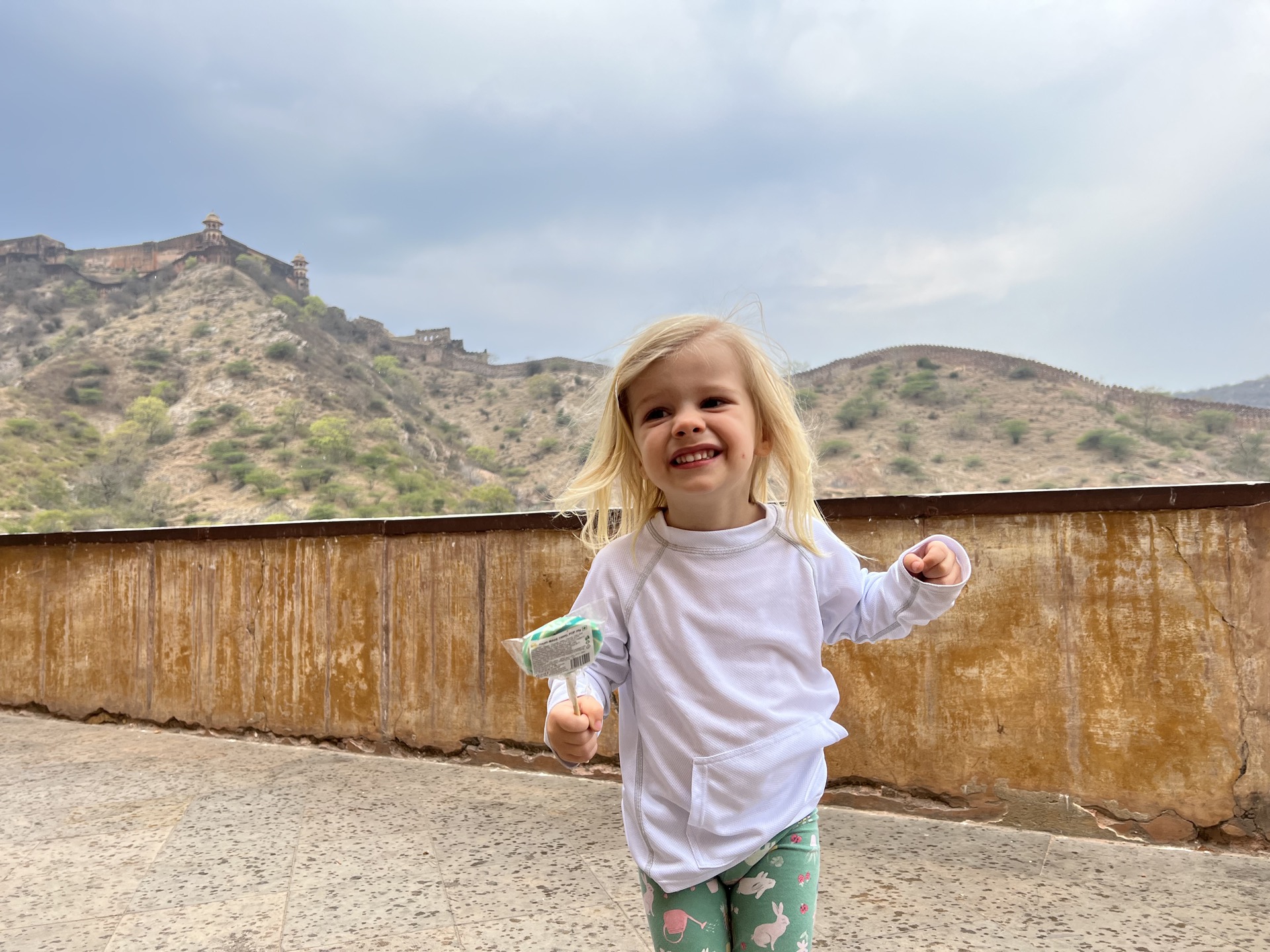
Our toddler loved everything India had to offer. They were thrilled riding in a rickshaw through Chandni Chowk in Delhi and they danced their way through the gardens at the Taj Mahal in Agra. They were thrilled to discover India has lollipops when they earned one at the Amer Fort in Jaipur, and they are still talking about how much fun they had at Holi in Udaipur. And don’t get me started on the hotel pools, which I do know are everywhere but hit different in India.
Then there’s the fact that they love kids in India – like a lot. It is one of the most kid-friendly countries we’ve ever been to, beating out countries in the Middle East that also really love kids (like UAE and Qatar). And kids weren’t just tolerated, they were fully welcomed everywhere we went.
Our child was treated like royalty at every hotel we stayed at, earning toys and desserts at every interaction. The hotels also had kid’s areas, kid’s pools (with floaties!), kid’s menus, cribs and high chairs, which made staying there with a child seamless and easy.
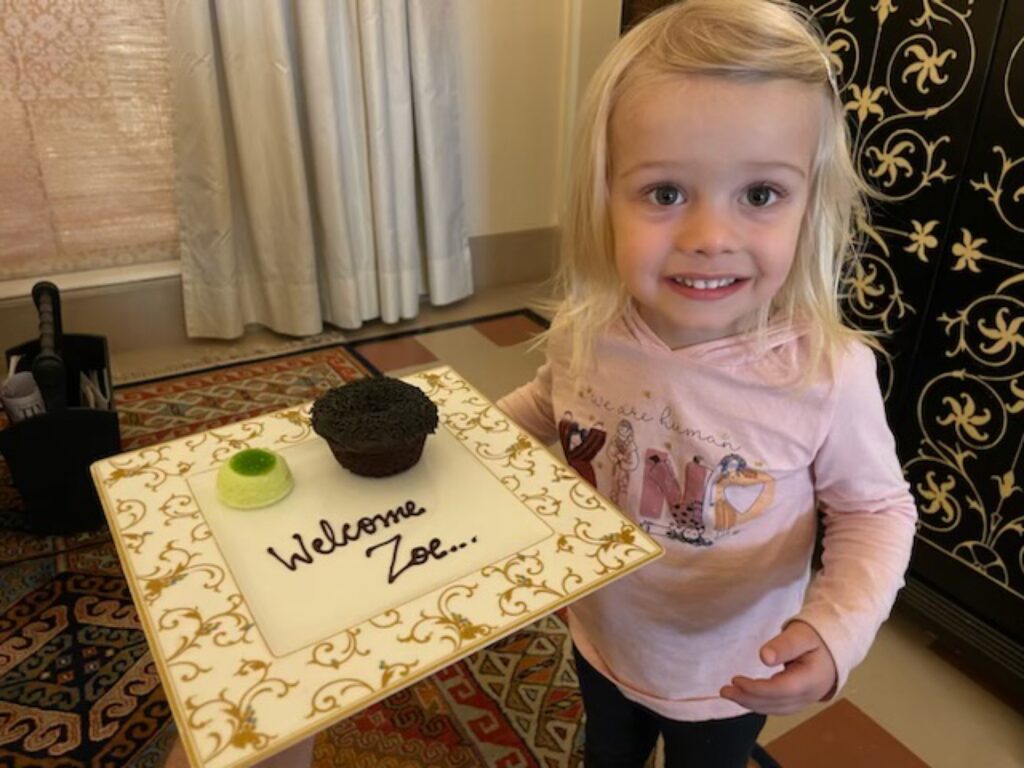
Our toddler also happens to be white and blonde, which drew a lot of attention. We were frequently stopped by strangers who wanted to take photos with us. This is common in India around Asia. For the most part, people were extremely respectful, and always asked for permission first.
However, they did often assume that a “yes” meant they could physically hold our child. Our toddler is pretty nervous around strangers and rarely was up for this. (Except during Holi when they let strangers pass them around for a good 10 minutes and it actually totally saved the day.) They would happily take pictures if I held them and also did pretty well posing and playing with other kids.
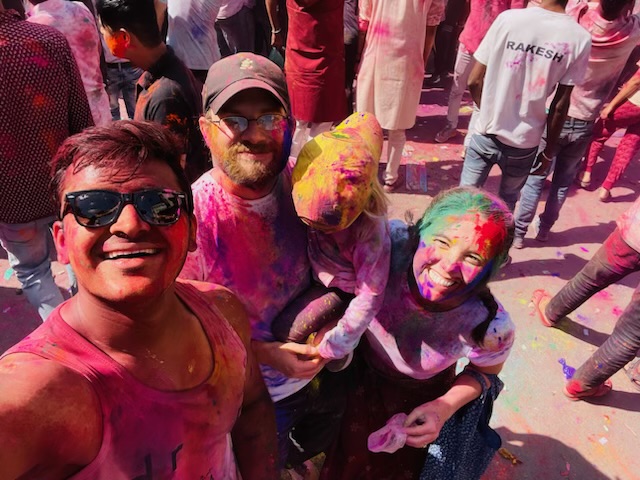
Which cities in India are best for traveling with kids?
India is a huge country and we’ve barely scratched the surface. But if you’re traveling to India with kids and it’s your first time to India, I can 100% say that the Golden Triangle is the way to go.
The Golden Triangle is the most popular tourist route in India and for good reason. It comprises Delhi, Jaipur and Agra. All three of these cities are a little bit different and a whole lot interesting. Delhi is the largest city of the three and has the most to see and do. It will also likely hit you with the most culture shock. Jaipur is quintessential Rajasthani, which is what I always picture when I think of India with the bright colors and tuk tuk traffic. And then there’s Agra, famously home to the Taj Mahal.
This route is really well traveled, which makes it great for families. It’s easy to travel between each city, there’s a good selection of hotels to choose from, and the cities are jam-packed with beautiful and interesting things to do. We personally spent three days in Delhi, two days in Jaipur, three days in Udaipur, and 2 days in Agra.
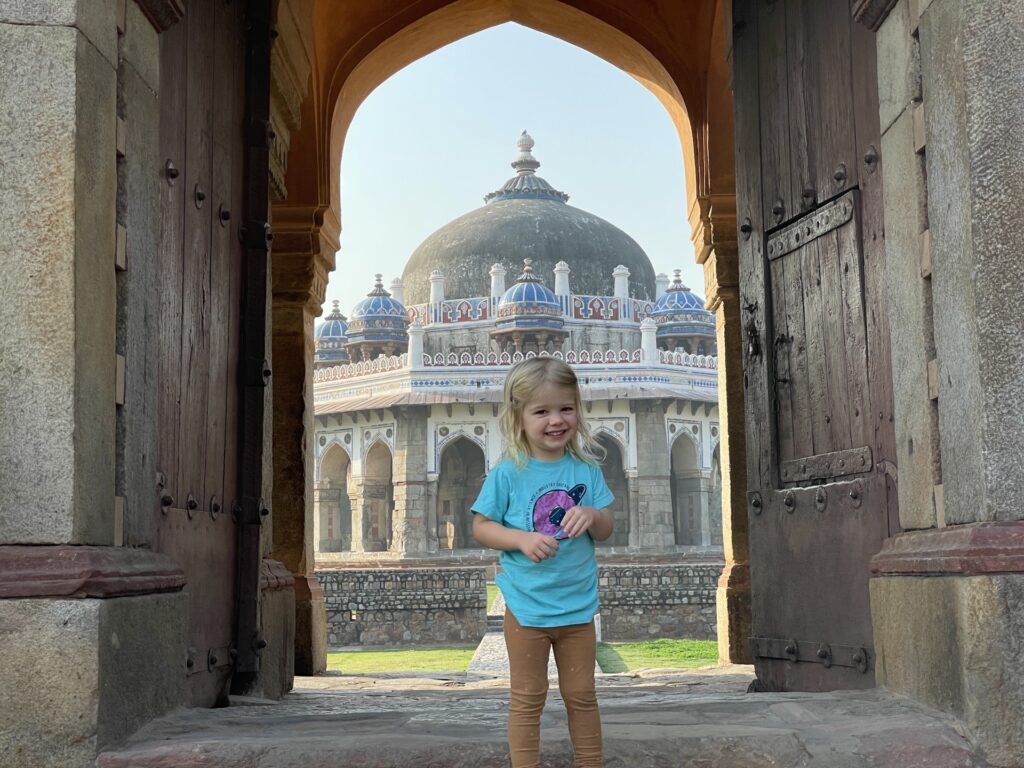
If you have extra time, you might want to tack on an extra city or two. We personally added Udaipur, which is the sweetheart of Indian cities. (I swear, there is not a bad thing written about Udaipur anywhere on the internet.) Udaipur is good for kids because it’s more relaxed and has a lot more nature and outdoor activities.
Another tempting option is Ranthambore National Park. It’s straight south of the Golden Triangle, and you can take a safari adventure for anywhere from 3 hours to two weeks. They technically don’t have age restrictions, so young children are welcome.
Getting Around India with Kids
Getting around India with kids can be tricky, but it is doable with the right planning.
The first thing to consider is getting around within a city. How will you get to your hotel from the train station or airport? How will you get to the different attractions and restaurants from your hotel each day? If you’re traveling with kids, you have two main options: cars and tuk tuks.
Then there’s the challenge of getting from one city to another. You can hire a driver, but India also has a very thorough rail network. Taking the train between cities is a cheap and convenient option, and can add to your adventure. Flying is another option, but don’t let the short flight times fool you.
Let’s look at all of these modes of transportation.
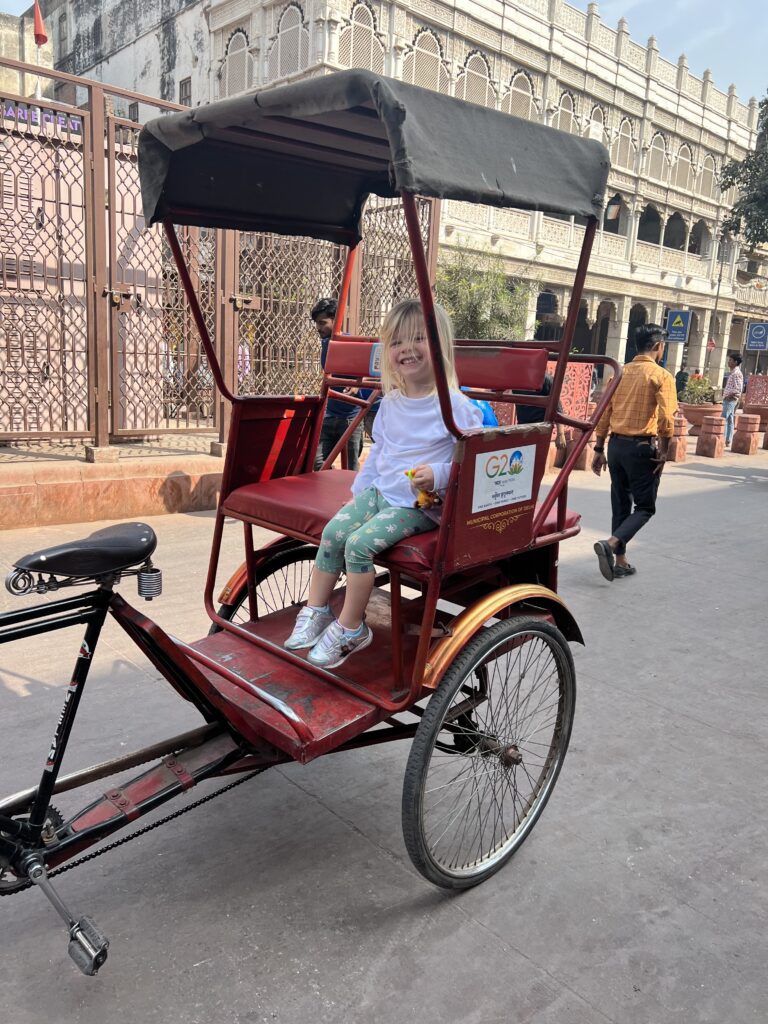
Kids and Car Seats in India
Usually we recommend using public transportation to get around cities with kids. However, that wasn’t ideal in India. Some cities did have Metros, but they were not very thorough. And with the exception of Udaipur, a lot of India wasn’t very pedestrian friendly. That meant that getting around required wheels. And when it comes to kids, wheels usually means a car seat.
Car seats are not legally required in India. Technically, you could just skip the car seat and ride in any taxi or Uber with your child. If you’re like us though, one look at Delhi’s chaotic traffic scene and you might immediately rule out that option.
Our next idea was to reserve a car service that had a car seat provided. (This was our approach for two days in Santo Domingo.) Unfortunately, every car service we reached out to in India didn’t have car seats.
So instead, we brought our own. We invested a hefty amount into a Pico portable car seat, which we thought might save us some money in the long run. The car seat itself was great. We could easily install it into any car whenever we needed to, which meant we could safely get from one place to the next.
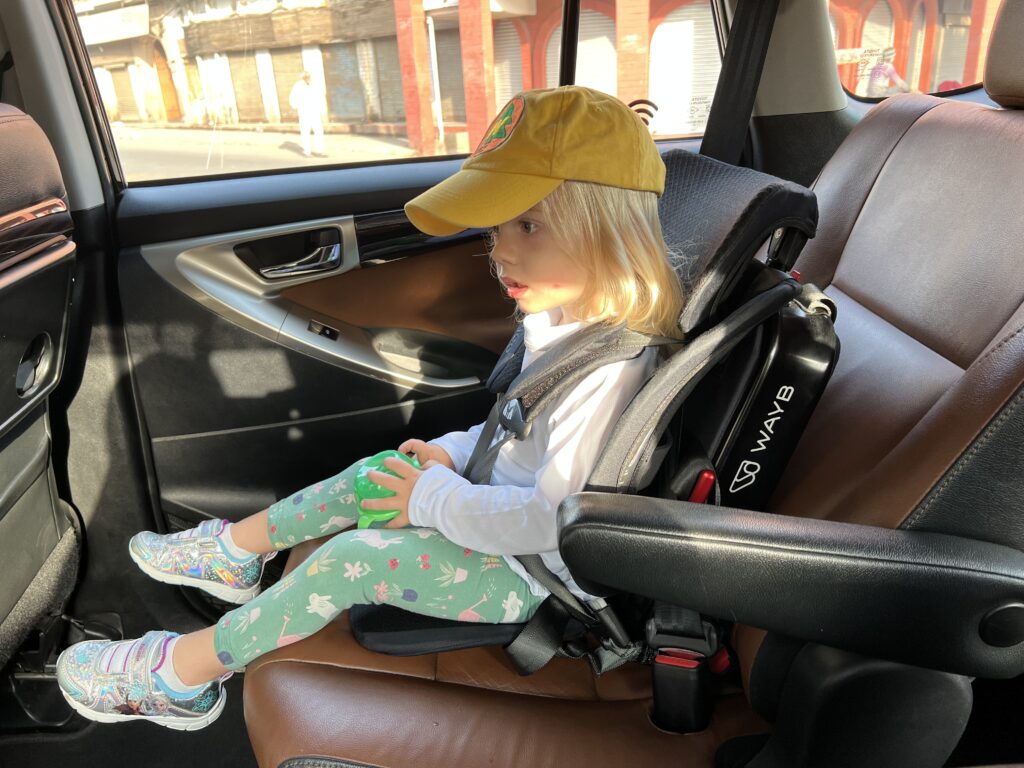
Unfortunately, that still meant that we couldn’t easily rely taxis or Ubers for sightseeing unless we wanted to carry around the car seat all day. At only 8 pounds and foldable into a nice backpack, that actually wasn’t the worst thing. However, many popular attractions in India don’t allow large backpacks, so we couldn’t always bring it anyway.
So what’s the answer to getting around with kids in India? Unfortunately, if you want to use a car seat, the best option is to bring a car seat and use a car service. That way, you can leave your car seat in the same car as you visit different attractions. (So no, the expensive car seat didn’t save us any money this time.)
Many high-end hotels in India can arrange a car service for you. We personally booked cars through The Oberoi (in Delhi, Udaipur and Agra) and Jai Mahal Palace in Jaipur to take us around to different destinations and pick us up from the rail stations. Alternatively, you can hire a private driver through a third party, which can be cheaper but more complicated.
Tuk Tuks in India
Another unique way to get around India is by tuk tuk. These little auto rickshaws are one of the most popular modes of transportation in India. The prominent style and color varies by region, so you’ll find yellow and green ones all over Delhi and brightly decorated ones in Rajasthan.
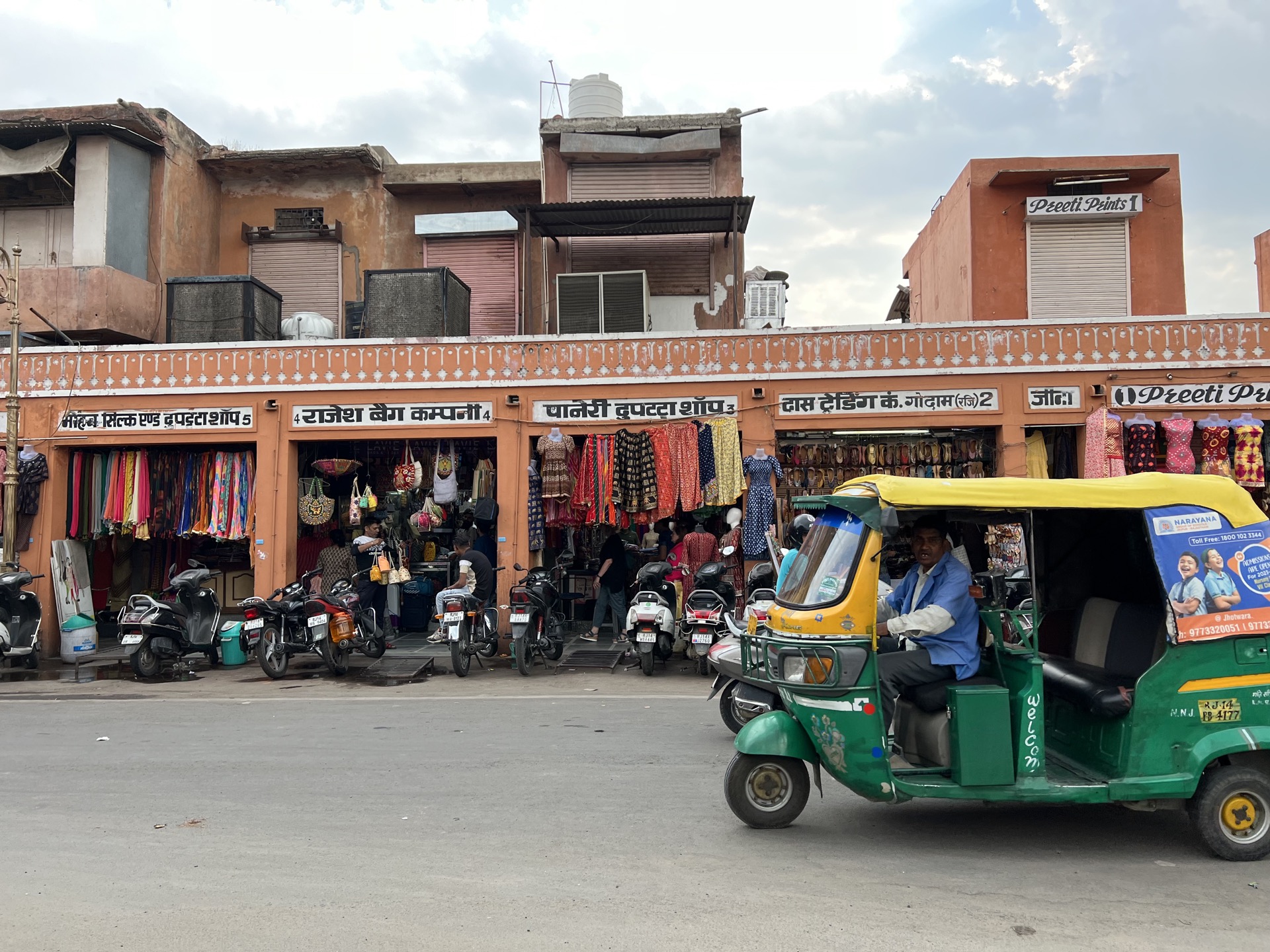
Tuk tuks usually hold 2-4 people, depending on the style, and max out at speeds of about 25 miles per hour. Tuk Tuks are a good, cheap option for covering short distances around a city.
The lack of car seats, seatbelts and doors is enough for some parents to rule out tuk tuks all together. We personally were comfortable riding in tuk tuks with our 2-year-old. It was our main mode of transportation in Udaipur specifically, which usually was less than 0.5 mile at low speeds with little traffic. We probably wouldn’t take a tuk tuk on the highway, but we were okay with it for short trips.
To hail a tuk tuk, flag down a driver and tell them where you want to go. Before you get in, ask how much it will cost and be prepared to pay in cash. Tips are appreciated, but are not required if you agree on a set price for a short trip.
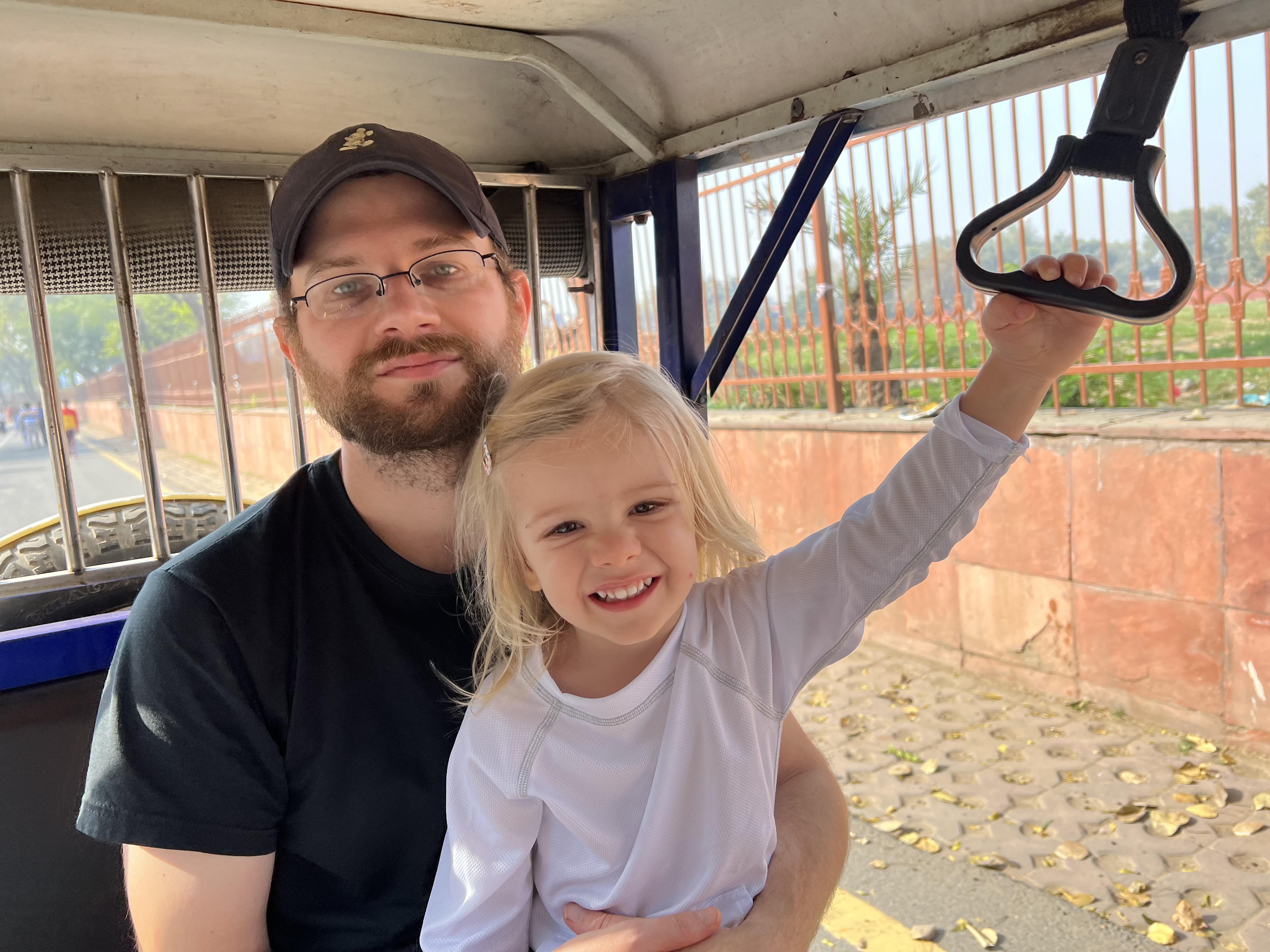
Riding the Train in India with Kids
Indian Railways is an efficient way to get around India, and it can be a good option in your traveling with kids. Here’s a list of the train rides we personally took with our 2-year-old.
- Morning train from Jaipur to Udaipur
- Overnight train from Udaipur to Agra
- Day train from Agra to Delhi
If you’ve seen the viral images of packed Indian trains, don’t panic. This is partly accurate, but it is entirely dependent on your travel class. To avoid any travel chaos, book the highest class available, which is usually still pretty cheap by Western standards. Be sure to book an AC car (regardless of your travel season) with assigned seats. To buy tickets, head to 12GoAsia for the most streamlined experience and great customer service. (Not sponsored, we’re just big fans.)
In our experience, the trains in India were always on time and very clean. The stations themselves were at times overwhelming (crowds, intense poverty, dirty), but they were easy to navigate and all signs were in both Hindi and English.
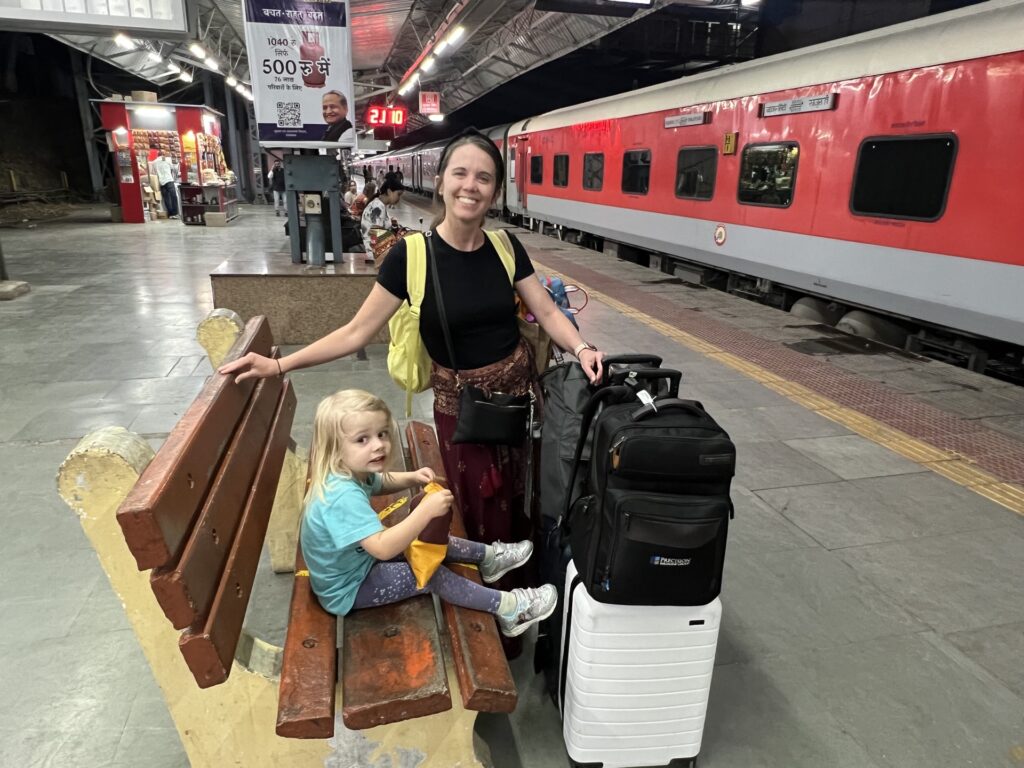
India is a big country, so the journeys can be long, even by train. Personally, we prefer longer trips with a toddler on a train compared to a car. We don’t have a car, and our little one isn’t used to being strapped in a car seat for long periods of time. On the train, they can get up and move around as needed, which is better for all of us.
Another downside to the trains in India is that the times are not always ideal for travel with a toddler. That’s why we ended up on a really early train and an overnight train.
Am I glad we took the overnight train? Yes. Would I recommend it? Maybe not. Our review linked above discusses some of the chaos we encountered on that train. I’ll admit that I don’t think the overnight train is the best option for all families, especially if you have a light sleeper. If you’ve never taken an overnight train before, I wouldn’t start with one in India with a kid.
Daytime trains though, I would absolutely recommend for intercity travel in India with kids.
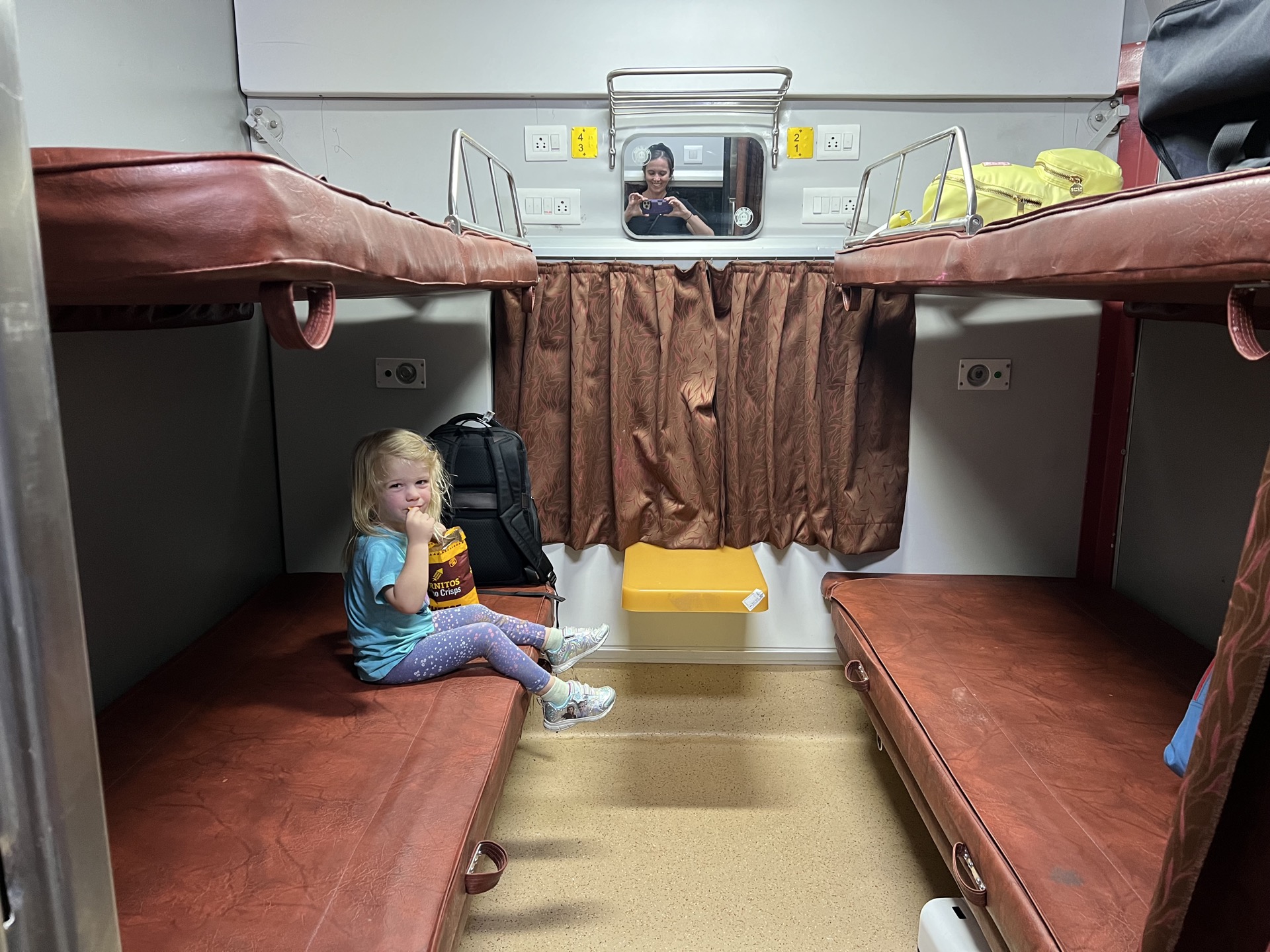
Plane Travel in India
Flying between cities in India is also an option. Domestic flights in India can be really cheap on carriers like IndiGo or SpiceJet. The flight times compared to train times might sound really tempting, too. The flight from Jaipur to Udaipur is only an hour, versus 7 hours by train.
I would still advise you to avoid or limit air travel in India. First, the airports are usually further away and harder to get to than the rail stations. Second, Indian airports are kind of a nightmare in terms of security and lines. When you factor in travel time to and from the airports and the hours early you have to arrive for security, you’ll likely find that it takes just as long and has even more steps than the train.
We had originally planned to fly from Jaipur to Udaipur, but once we did this math, we settled on the 7 hour train instead. When we flew out of Delhi to Doha at the end of our trip, we were immediately grateful that we didn’t have any other India airport experiences.
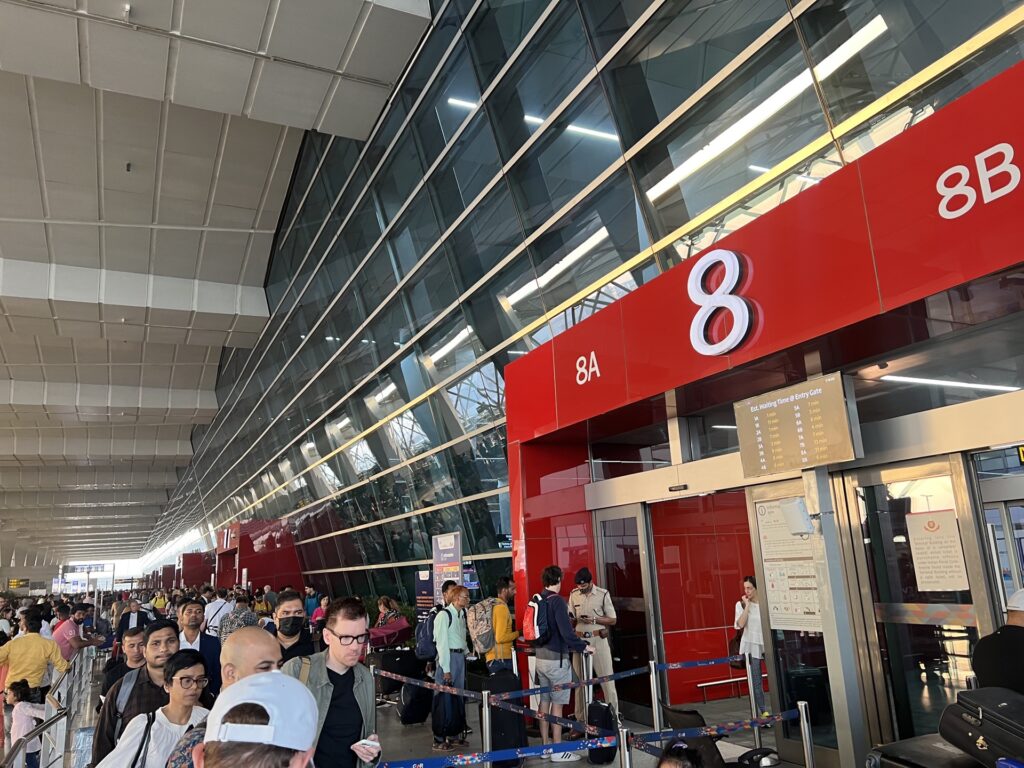
Eating in India With Kids
When it comes to kids, there are two main concerns for food in India: food safety and cuisine.
Food safety is the most important thing. Tap water in India is not safe to drink and can often cause traveler’s diarrhea. This is inconvenient and uncomfortable at best, and dangerous and trip-ending at worst.
Fortunately, there are ways to protect yourself that include more than just not drinking the tap water.
- Only eat fruits and vegetables that have a thick peel that you peel yourself, like bananas or oranges. (Produce might have been washed in contaminated water.)
- Stick to cooked, hot food.
- Use bottled water to brush your teeth, even though you’re not swallowing the water.
- Avoid street food. (I know it’s hard! You might be okay, but you might not be.)
- Stick to restaurants that have a lot of positive reviews, preferably from foreigners.
- Skip ice and fruit wedges in drinks and cocktails.
- Pack stomach meds (Children’s Mylicon, Pepto Bismol and Tums) and Pedialyte packets just in case anyone does get sick.
Some parents also worry about the local cuisine. What will my kid eat? Will it be too spicy? Will they like it? I think people think that kids in India will eat nothing but rice and dal and mango lassi every day. Let me assure you that (if you choose), your child can eat pasta and pizza everyday in India just like they do at home.
Very early in our travels, we learned that you can find western food literally everywhere, and India is no different. There is a McDonalds in Chandni Chowk in Delhi, a Pizza Hut in Jiapur and a Starbucks in Udaipur. I’m not saying you’ll want to or need to resort to American fast food, but think of it as a safety net.
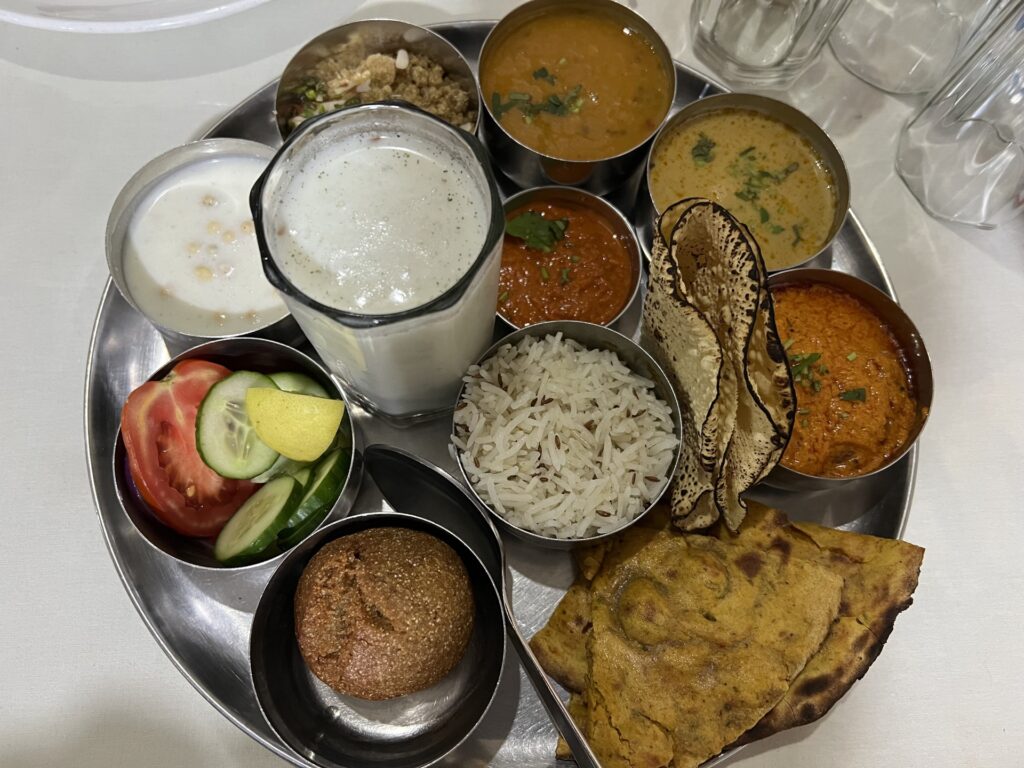
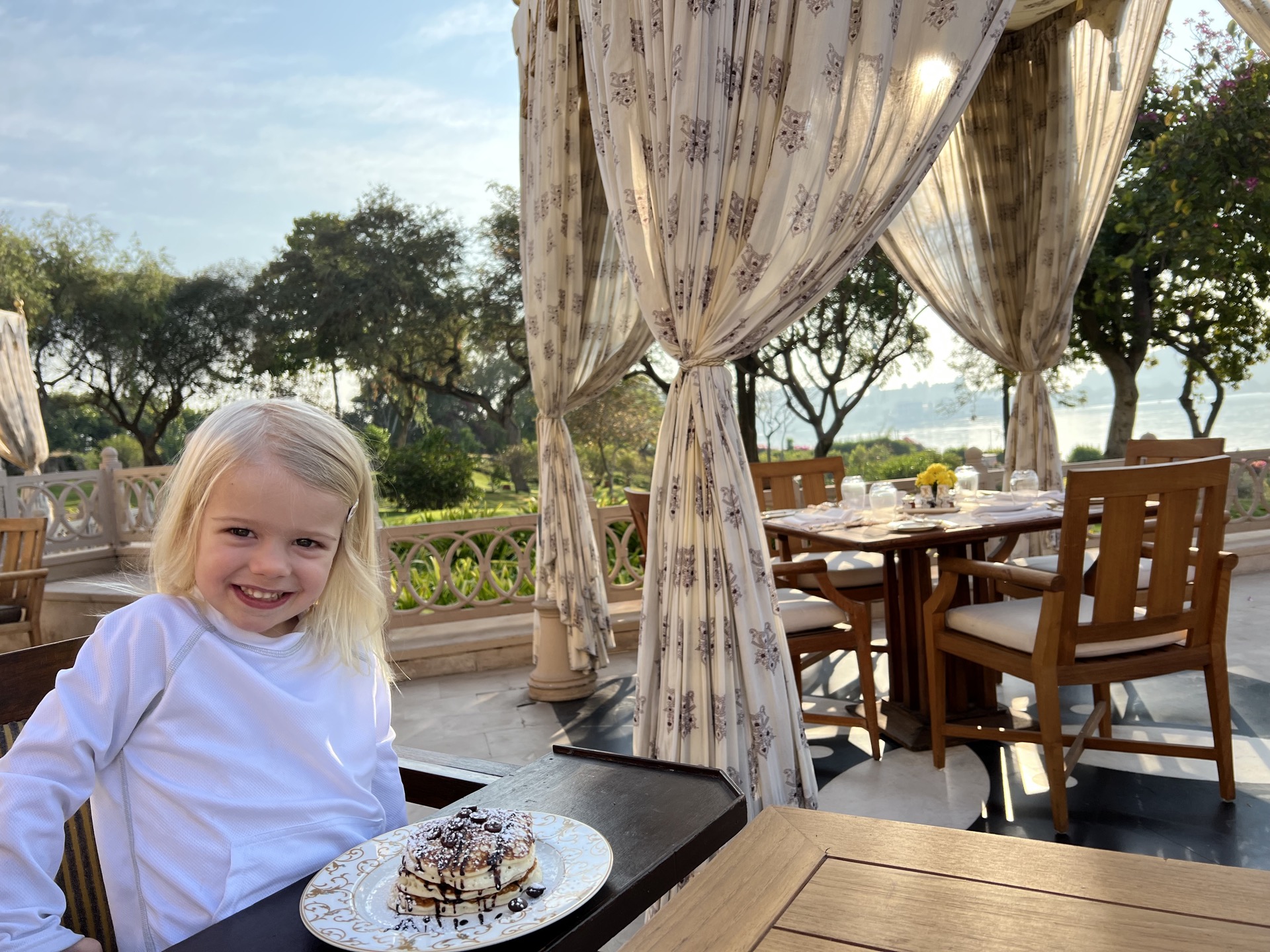
Relevant to both of these food concerns, we ate almost all of our meals in our hotel restaurants. We were confident the food was as safe as possible, but we still stuck to fully cooked foods only. The menus at all of our hotels had Indian food that we could enjoy as much as possible, but also a wide variety of international foods that appealed to our little one. Our 2-year old dined on their finest veggie sliders, pizza, and of course, the occasional dal and palak paneer.
Other than missing fresh fruit (because we chose to avoid it), the only thing we sort of struggled with in India was snacks. Our toddler is a snacker, so we always needed to get something small while we were out and about. We only ate packaged foods, so that meant they at a lot of chips and juice boxes. That obviously isn’t the healthiest option, but it was a 2-week trip and that’s just what we needed to do.
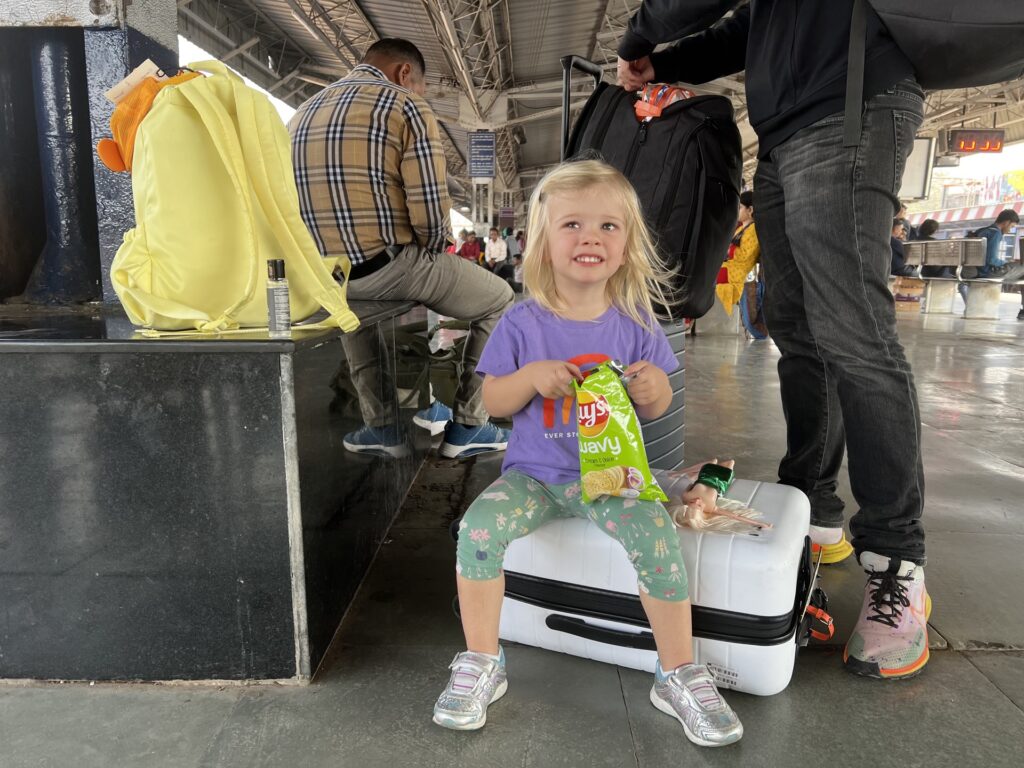
What is the best age to bring a kid to India?
How old are your kids? That age is the best age to bring them. I’m kidding, but also not.
Honestly, I think a trip to India can be great for any kids around 2 and up. I say 2 and up because it’s not the cleanest place. I wouldn’t want to be there with a crawler or wobbly walker spending too much time on the ground in public places.
Many of the tourist sites actually did have changing tables, but I can’t vouch for how clean they were. We personally handled most of our diaper changes on our portable changing mat anywhere we could find space (grass in the park, behind a car in a parking lot, a step of a step well, etc.).
Otherwise, India is great for even the youngest of kids. Even at 2, our toddler had a great time. I think they probably loved Udaipur most because they got to ride tuk tuks, take the “Skyliner” (gondola to a hilltop temple), and play Holi, but they found fun everywhere they went.

I think it’s less about how old your kids are and more about how comfortable you all are with travel. If you’ve never traveled as a family before, I’d probably start with an easier city (maybe London or Amsterdam) first.
I would also suggest waiting until you can financially afford to do India as a bougier trip, especially if you’re going with little kids. A nice hotel will make all the difference when it comes to how much you all enjoy an India trip. If you stay at a nice hotel, no matter how old your kids are, you will be fine.
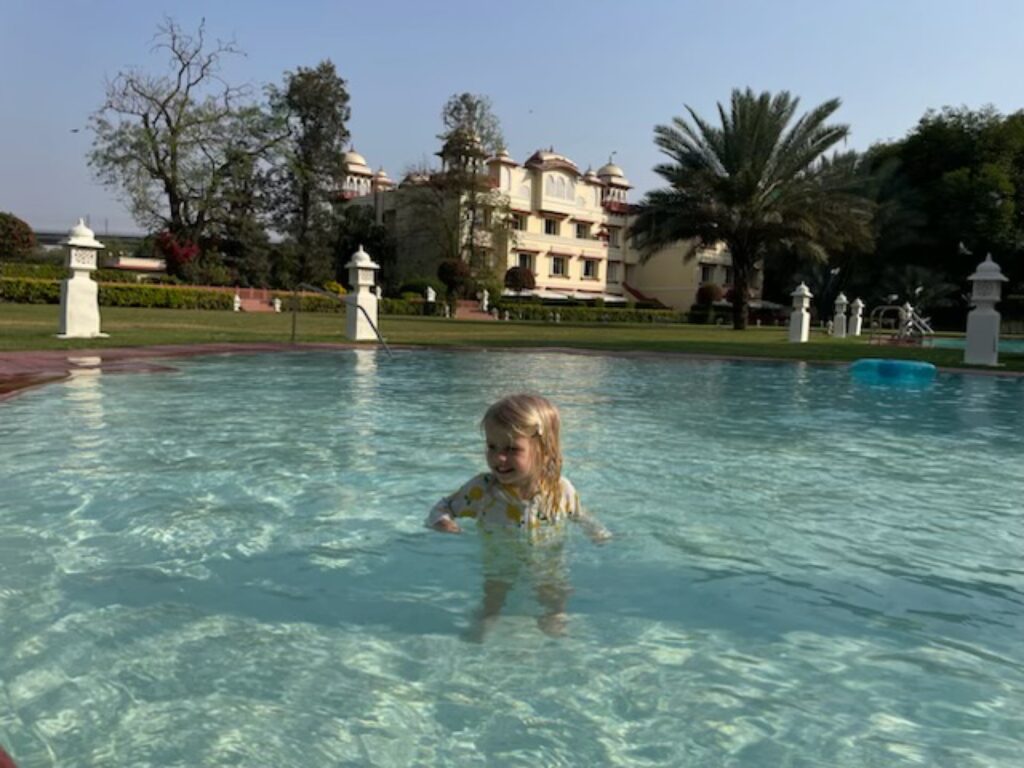
Part 2: Plan Your Trip
In the above section, we covered more broadly what it’s like to travel to India with kids. Now we’re moving onto the more granular details of planning your trip. These next sections go over everything you’ll need to know to finalize, book and prepare for a trip to India with kids.
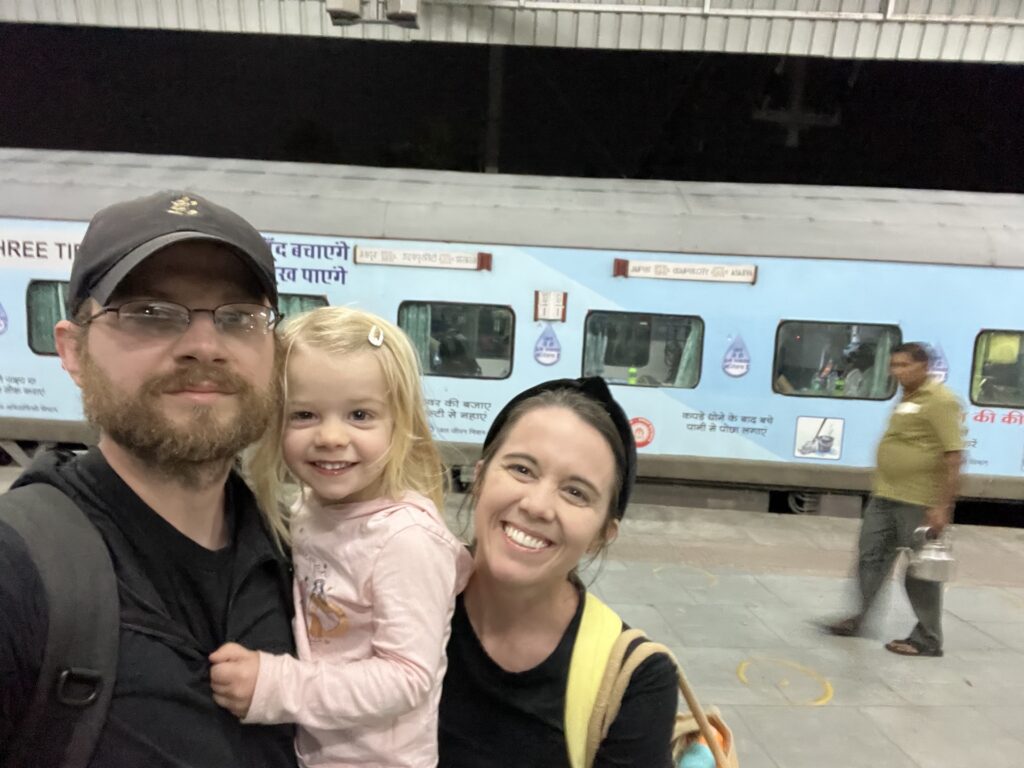
Plan Your Route
Start by choosing your cities. How many cities you can fit in will depend on how long you have and what type of traveler you are. Some people are fine changing hotels every few days, while others prefer to park it at a home base, focus on one place and then take day trips as needed.
When you’re choosing your cities, be sure to plan for how you are going to get between cities. Some cities are easy to get to by train, some require a flight, and sometimes hiring a driver might be the best option. I’d recommend cities that are accessible by train or by car (with a driver).
If it’s your first time to India, we’d suggest sticking to the Golden Triangle, which includes Delhi, Jaipur, and Agra. You can do the Golden Triangle in either direction. Agra is primarily the Taj Mahal, so you could do it as a day trip from Delhi instead as long as you don’t care about sunrise.

When To Go & How Long to Stay
The best time to visit India is October through March. June through September is monsoon season, which you definitely want to avoid, and April and May start to get really hot.
The other thing to consider when planning your trip is holidays. We celebrated Holi in Udaipur, and it was the highlight of our trip. If we come back to India one day, we’d love to plan it over Diwali. Holidays can offer a special local experience, but they can also have a negative impact on your trip. Be sure to account for travel delays, crowds, and closed attractions that may result from the holiday.
For a family trip to India, I would plan for at least 10 days, but ideally closer to two whole weeks. With two weeks, you can choose to do everything slower or you can add an extra city.
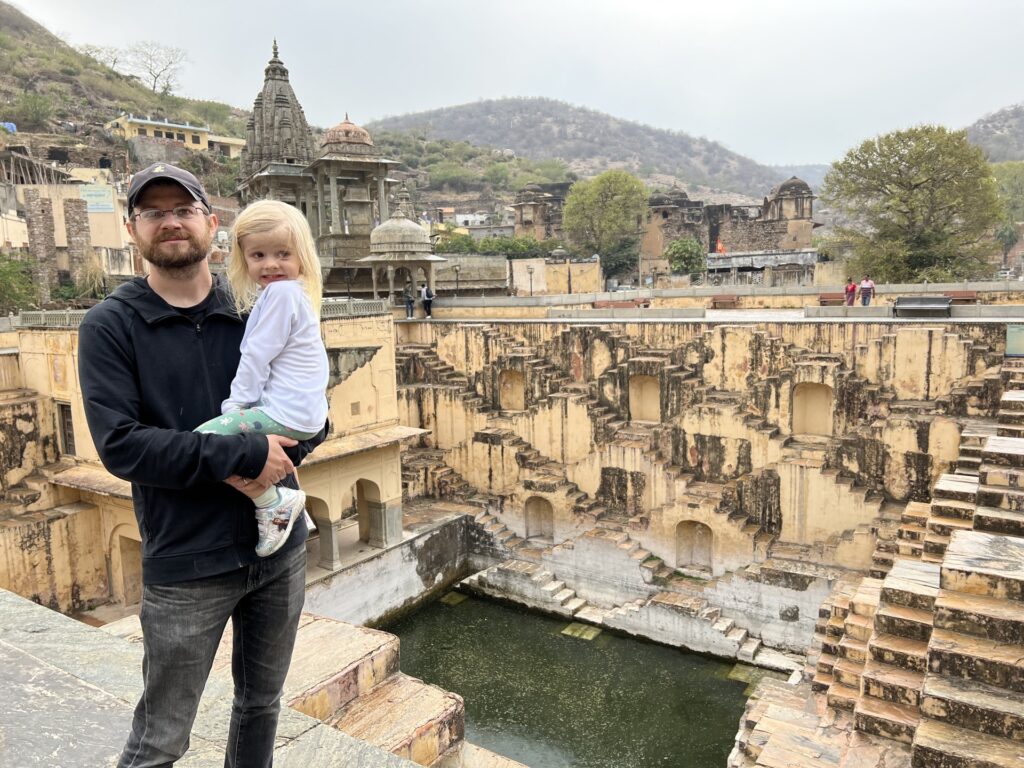
Here’s a look at how many full days I would spend in each of these popular cities in India. This does not account for travel days, which will likely take a full day between each city.
- Delhi: 3 days
- Jaipur: 2 days
- Udaipur: 3 days
- Agra: 2 days or a day trip from Delhi
If you are short on time, I would suggest skipping Jaipur. It was our least favorite city and our toddler loved the other places so much more. If I had 7-10 days, I would probably split my time between Delhi and Udaipur and then take a day trip to Agra for the Taj Mahal.
Choosing a Hotel in India For a Family Trip
At the risk of sounding dramatic, I would argue that your hotel selection can make or break your trip to India with kids. More than anywhere I’ve ever been, I needed a hotel oasis in India. I needed a comfortable, calm and quiet place to recharge after mornings exploring the busy cities. If you’re traveling with a kid, especially a younger one, this is even more important.
India can be intense and a bit of a culture shock, depending where you’re coming from. I wanted to give it my fullest attention so I could fully appreciate it. Because I had the the chance to reset at our nice hotels, I was able to do that. I think the country deserves that. I firmly believe that we loved India so much more because we could approach each day with a fresh set of eyes.
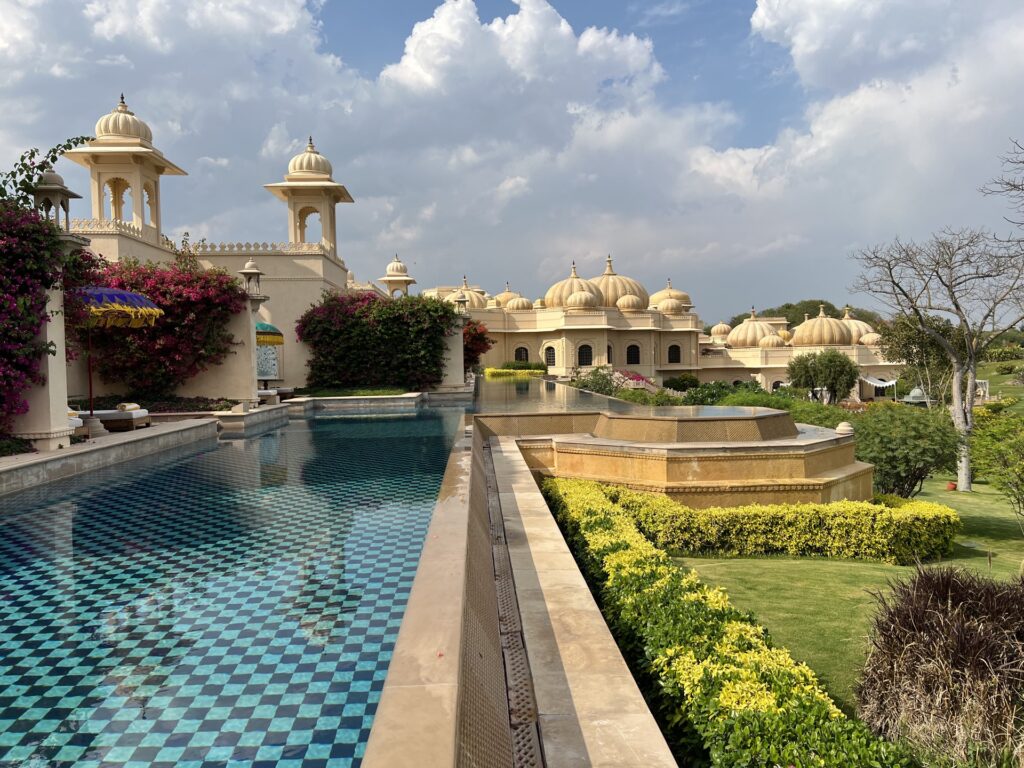
So, what should you look for in a hotel in India? I would prioritize hotels that have all-day dining and a swimming pool. Double check that the hotel has cribs available if you’ll need one. It’s also helpful if you choose a hotel that offers a car service or can help coordinate one for you. That makes getting to the hotel from the train station or airport easy, and it can make your touring days that much smoother.
Here’s a look at the hotels we stayed at in India with our toddler. As you can see, we erred on the side of luxury and it made our trip incredibly pleasant. (If anything, I’d argue that it made our trip too sterile, but I don’t regret it.)
- Delhi: The Oberoi New Delhi and JW Marriott New Delhi
- Jaipur: Jai Mahal Palace (no cribs)
- Udaipur: The Oberoi Udaivilas
- Agra: The Oberoi Amarvilas
I would recommend all of these hotels except the Jai Mahal Palace, which we personally didn’t love.
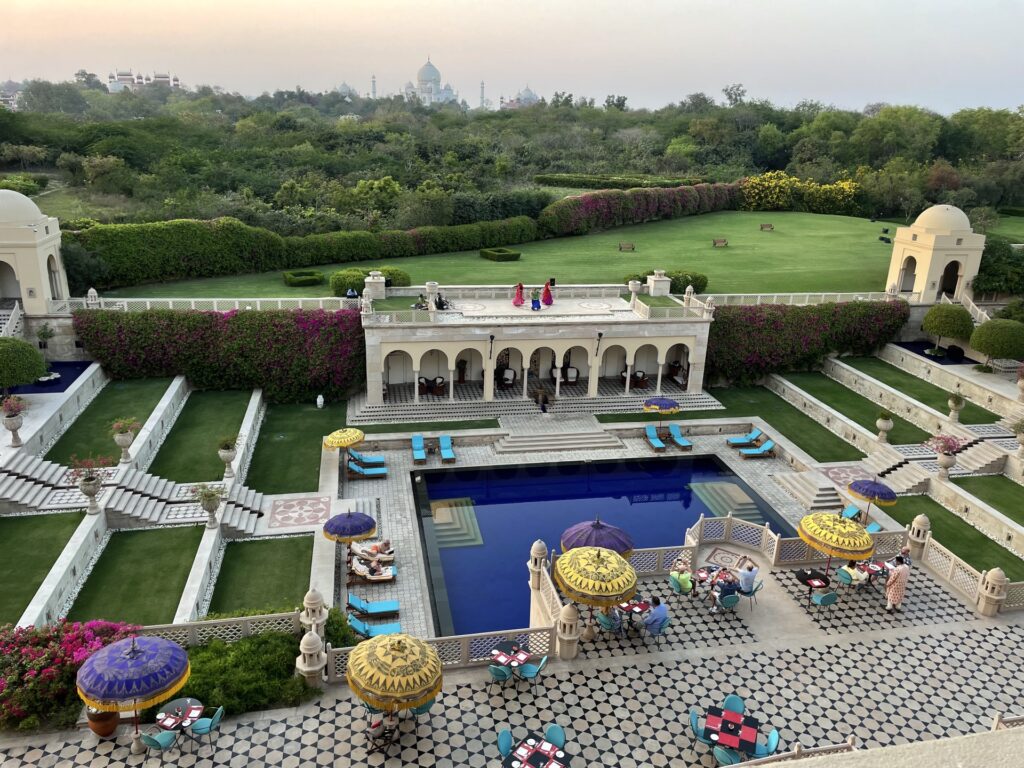
Selecting Flights to India with Kids
India has 34 international airports, but Delhi and Mumbai are by far the busiest in the country. Given how hard we’ve pushed the Golden Triangle route, we’d recommend flying to Delhi.
Many international carriers fly to Delhi, including the country’s flag carrier airline, Air India. Although we had a perfectly fine flight in Air India Business Class from Dubai to Delhi, it’s not necessarily an airline that you need to go out of our your way try on a long haul flight. Instead, I would suggest flying your preferred airline in your home country if they have flights to Delhi.
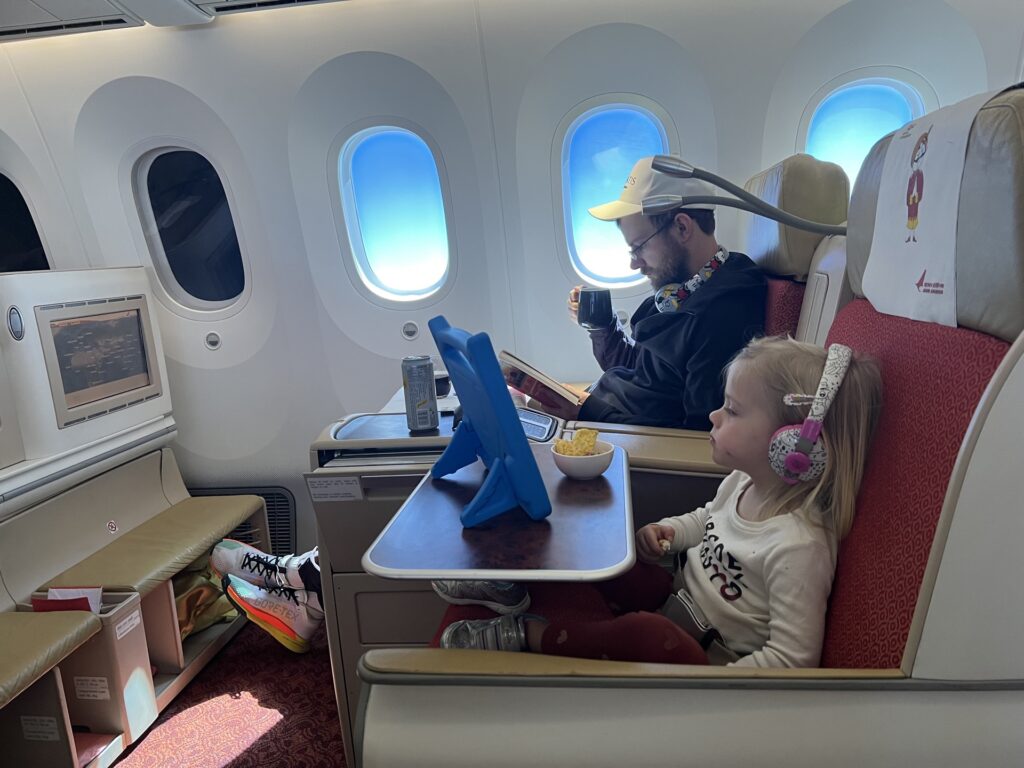
Now, if you’re coming from really far away (like the Americas or even western Europe), we have a hot tip that will be insanely helpful if you’re traveling with kids. Considering adding a buffer city on the front end of your trip to adjust to the time change and relax before diving into India. We flew from New York City to Dubai (Business Class on Emirates) and then spent four nights at Atlantis, The Palm, and it worked out perfectly.
It was then just a quick flight from Dubai to Delhi and our child was ready to hit the ground running in India. They were mostly adjusted to the time change, they were no longer groggy from the flight, and they were fully in vacation mode. Highly recommend!
The last thing to consider when booking your flights to India is the times. To help with jet lag, always fly during the day when you travel east to west and through the night when you travel west to east.
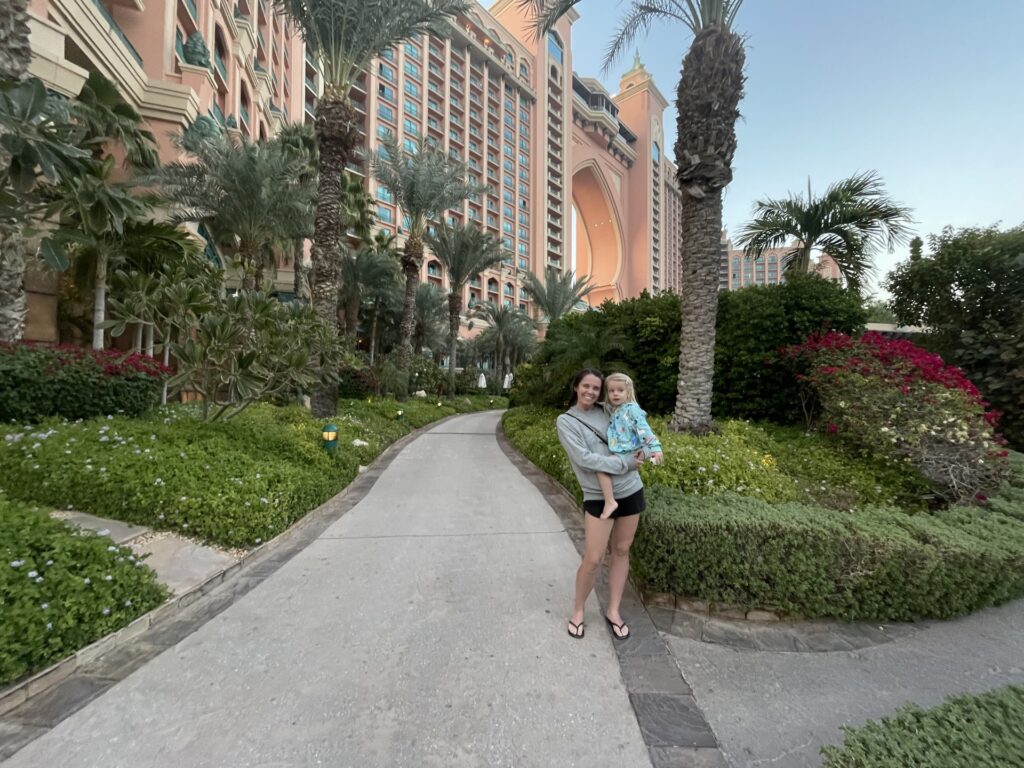
What Vaccines do Kids (And Adults) Need For India
India does not have any vaccine mandates, but you might want to get a few before traveling there. In the United States, the CDC recommends the following vaccines for travelers going to India. Other countries may issue different recommendations.
(Disclaimer: We are not doctors and this is not medical advice. Consult your physician or a travel clinic for professional recommendations.)
- COVID-19
- Hepatitis A
- Hepatits B
- Measles
- Yellow Fever
- Rabies
- Typhoid
- Cholera (regional)
- Malaria (regional)
- Japanese Encephalitis (regional)
We were already up to date with most of these vaccines including: Covid, Hep A, Hep B and measles. We also already received Yellow Fever vaccines before traveling to Colombia a few years ago, but wouldn’t have messed with it just for this trip. Based on our travel plans (Delhi, Jaipur, Udaipur, Agra), we weren’t at high risk for cholera, malaria or Japanese Encephalitis. That left us with Rabies and Typhoid to consider.
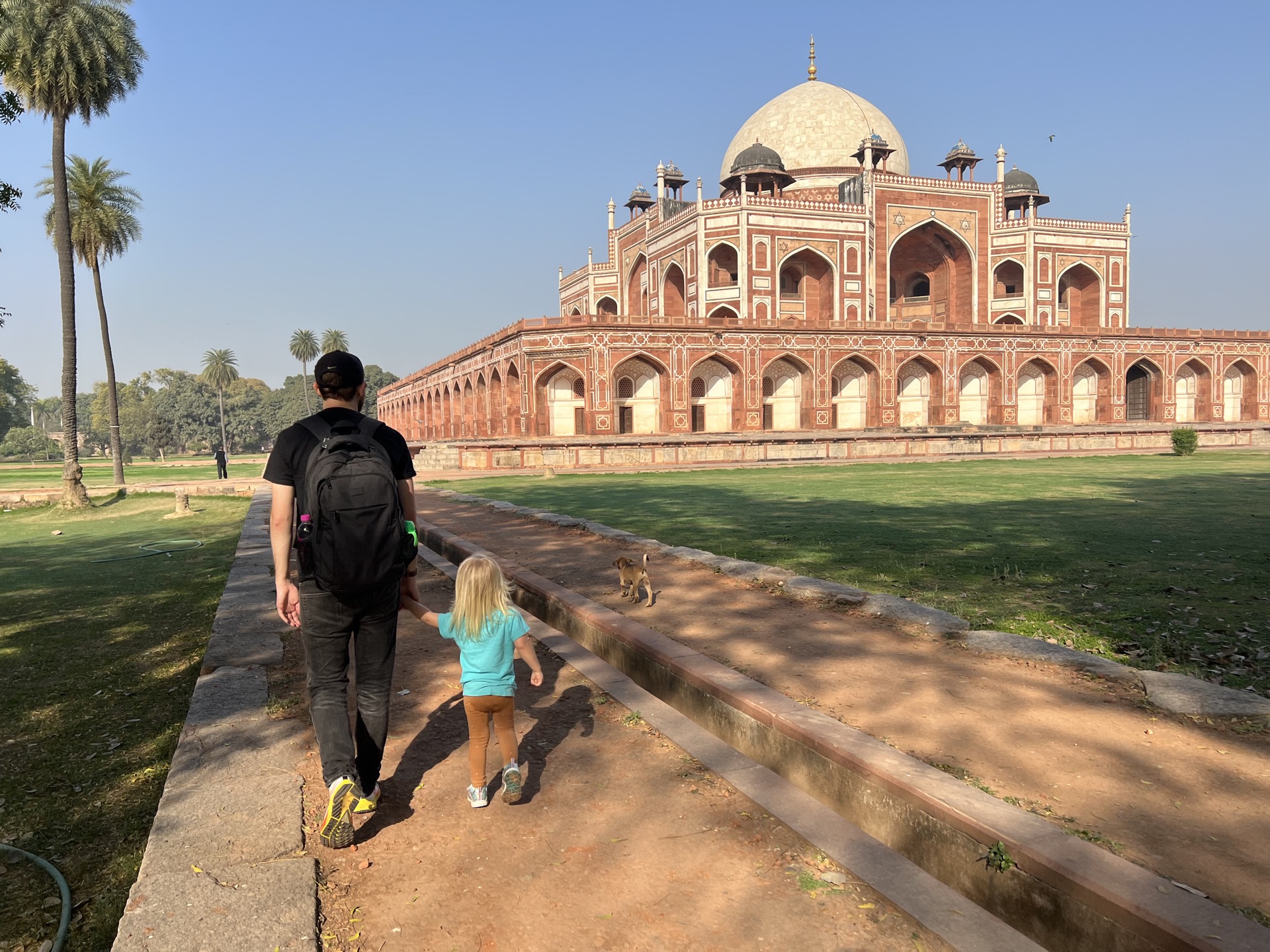
To help guide our decision, we scheduled a travel consultation with our pediatrician. If you want to do this for peace of mind, by all means go for it, but it turned out to be a waste of time for us. Our doctor basically just read the CDC website to us.
She wanted to be sure our toddler got their final Hep A vaccine (which they were already due for), but didn’t strongly recommend either Rabies or Typhoid. In fact, she actually had just traveled with her own infant to a country that also had a Typhoid recommendation and she didn’t have her child vaccinated.
We decided to skip the rabies vaccine. Stray dogs are definitely a thing all over India, but we assumed we would be able to stay pretty clear of them. Typhoid spreads through contaminated water, though, and that seemed like a risk that would be harder to avoid completely. We decided to get the Typhoid vaccine for all of us. Our toddler got it at our pediatrician’s office and we got ours at CVS MinuteClinic.
The Typhoid vaccine is expensive — usually costing $150 out of pocket. Our pediatrician charged us in full, but then we actually realized that our insurance covered it. We disputed the charge and got our $150 back that day. So be sure to check your insurance! Insurance did not cover our adult vaccines.
Getting a Visa for India
First and foremost, every member of your travel party, including children, will need a valid passport from your home country. Then, each traveler will need a tourist eVisa to enter India.
Tourists from most countries can request a Tourist e-Visa in three available durations (30 days, 1 year, 5 years). It’s not hard to get, but it can take time, so be sure to do it ASAP. We’d recommend getting this taken care of before you book you flight, just in case anything goes wrong.
You can apply for an Indian Tourist e-Visa online. You will need to submit one form for each member of your family. To complete the form, you’ll need a valid passport and passport photo. You’ll also need a credit card to pay the application fee, which will be $10 or $25 USD for a 30-day visa.
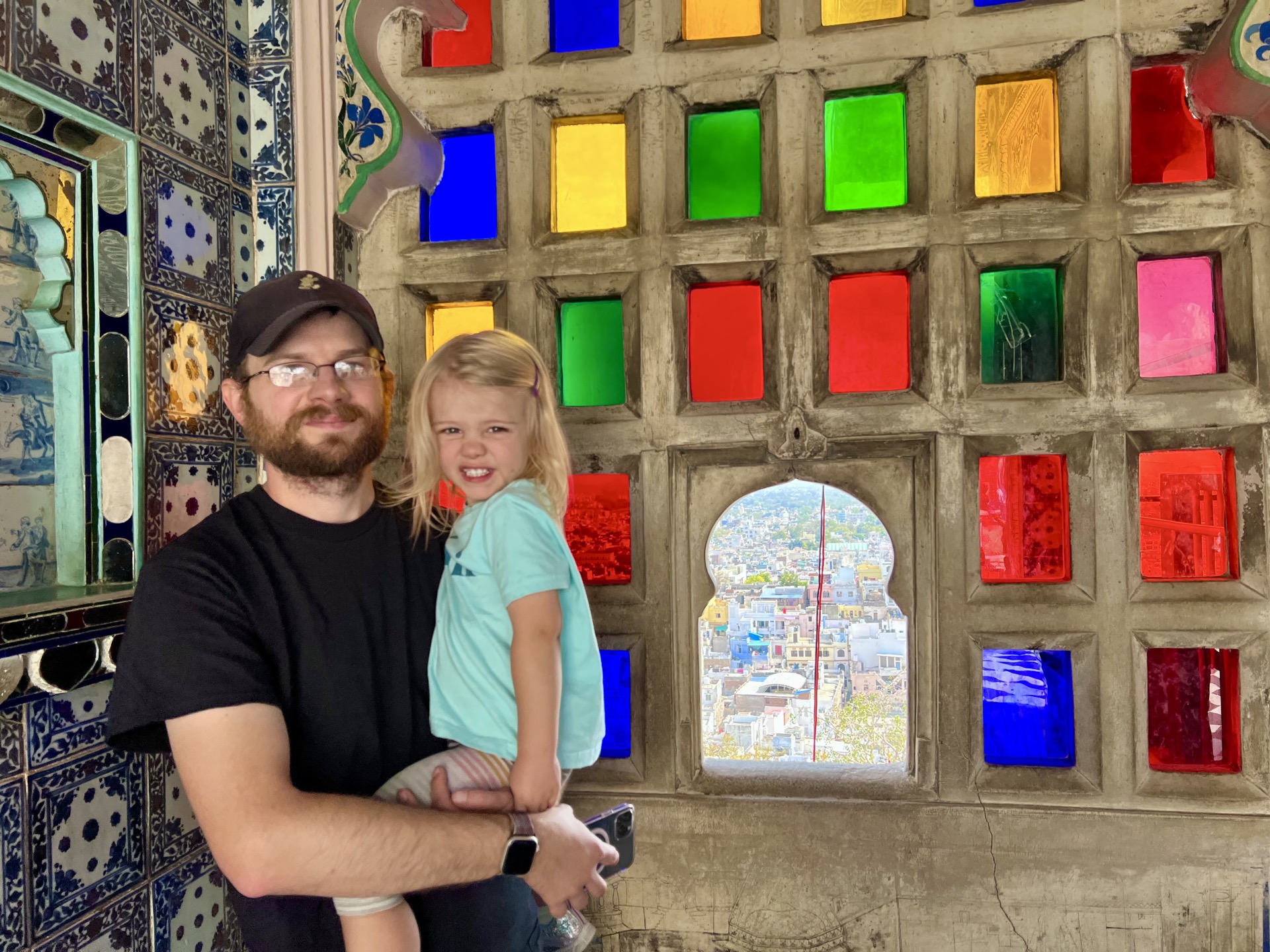
Planning Your Daily Itinerary
As you start piecing together your plans for each day, my best piece of advice is balance.
We have always been busy travelers. We’re not great at relaxing, so we usually try to see and do as much as possible when we travel. Even since we had our kid, we still usually pack our days pretty full, we just added a nap in the middle.
That didn’t work for us in India. We found that we only had enough energy to commit a half day to sightseeing in India and then we all needed a break. We decided we would get up early every day, spend the morning doing all the things, and then make it back to the hotel by 1 PM for lunch and nap.
During nap time, one parent would stay with the baby and the other would run in the gym, explore the hotel, or have a beer at the hotel lounge. Then we’d spend our afternoons swimming in the pool and playing on the playground before enjoying a relaxing dinner at the hotel. Balance.
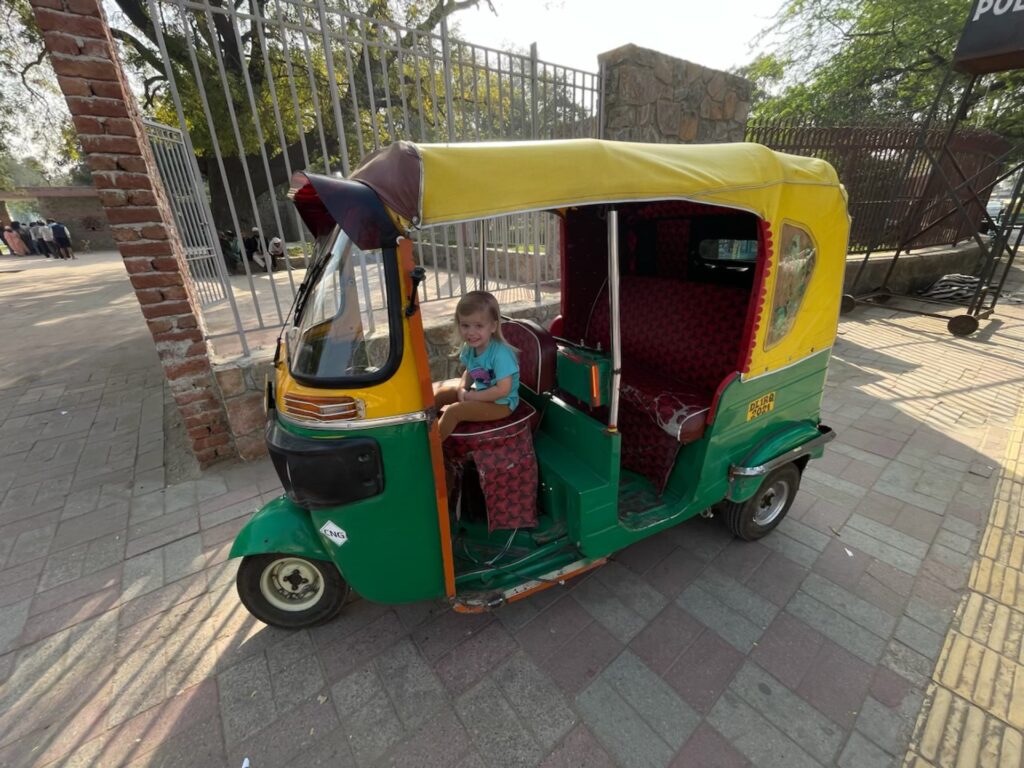
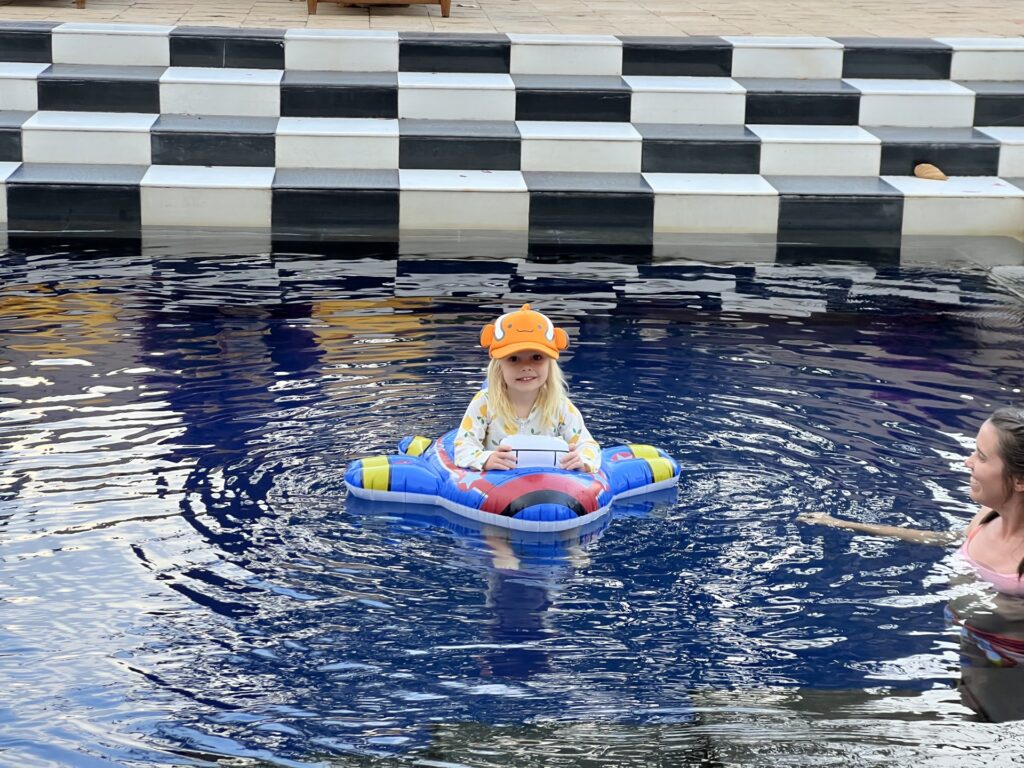
This mornings-on-afternoons-off model worked really well for us. In fact, the only time we didn’t do this was in Jaipur. We tried to cram everything into one long, nap-free day and our toddler ended up passing out in the carrier in the middle of a market until their legs fell asleep.
It’s also important to balance your specific activities, too. If we had a busy market where we’d have to carry our child, we’d follow that up with a garden or tomb where they had space to run around. If we started at a palace that seemed “boring” for them, we’d follow it up with an adventurous activity like riding the gondola.
For a closer look at how we spent our time in India with a 2-year-old, check out these itineraries:
What to Pack for a Trip to India with Kids
This is not a detailed packing list. This is a list of the extra things we brought for India specifically that ended up being really helpful.
- UPF Hoodie: We got this UPF hooded onesie for our baby for trips to Disney World, and we loved that it provided sun protection without the hassle of sunscreen (or at least less sunscreen hassle). We wanted something similar for India and got this one with a hood and this lighter weight one without.
- Baby Carrier: India is not great for strollers. If there are sidewalks at all, they are bumpy and there are lots of stairs without ramps. If you’re child is old enough to walk the whole time on their own, pack a baby carrier. Our toddler walked most of the time, but we also brought our favorite low-profile carrier, the Sakura Bloom Onbuhimo carrier. We also have a guide to baby wearing for travel where we review other carriers, too.
- Dish Soap: I recently started bringing a small amount of dish soap in a travel-size bottle and it was a game changer. We give our toddler milk in their cup and we always travel with a bento box that we use to store leftovers for future meals or snacks. The dish soap allows us to do that without anything getting gross.
- Water Purifier Water Bottle: It’s not safe to drink the tap water in India, so we relied on bottled water. I’d love to say that this water bottle eliminated our need for single-use plastics, but it didn’t. It’s just too small and we trusted bottled water more. However, this water bottle allowed us to purify hotel tap water if we were ever in a pinch. We mostly used this for brushing our teeth.
- Baseball Hat: This was partly for sun protection and partly for social protection. Our toddler is blonde and stood out like a sore thumb. The hat covered them up a bit when they didn’t want attention. The brim also helped them block out people when we were in crowded spaces, which helped them feel less overwhelmed.
- Liquid IV or Pedialyte Packets: If anyone in your family gets traveler’s diarrhea, these will help prevent dehydration. It’s also good great to improve everyone’s hydration on travel days.
- Medicine: Again, if anyone in your family gets sick, it’s good to have something handy immediately that you know exactly what it is. We brought Children’s Mylicon, Pepto Bismol and Tums for stomach issues and Tylenol and Children’s Tylenol for everything else.
- Entertainment: Whether that is a tablet and headphones or special activity books, bring stuff to keep kids busy in car rides and train rides. If you go the tablet route, be sure to download shows and movies in advance. The selection is different in India, plus you won’t have wifi or service everywhere.
- Portable Charger: We bring our power bank everywhere, but it’s extra important on travel days. Your battery will die faster taking more photos, looking up directions and downloading online tickets. A bigger one is also good for hotels if there are no outlets by your bed.
- Photos From Home: This isn’t necessary, but it can be really nice on a long trip. We brought photos from some of our favorite places at home, plus photos of places we were going. We could use our phone too, but this way our kid could look at the physical photos on their own whenever they want.
- Ziplocks: This is another thing that I just bring anytime we travel. You will use them for went clothes on travel days, snacks that you accumulate, keeping your phone dry when it rains, and about a million other things.
- Travel Car Seat: If you plan to take any cars in India, you’ll need to bring your own car seat if you want to use one.
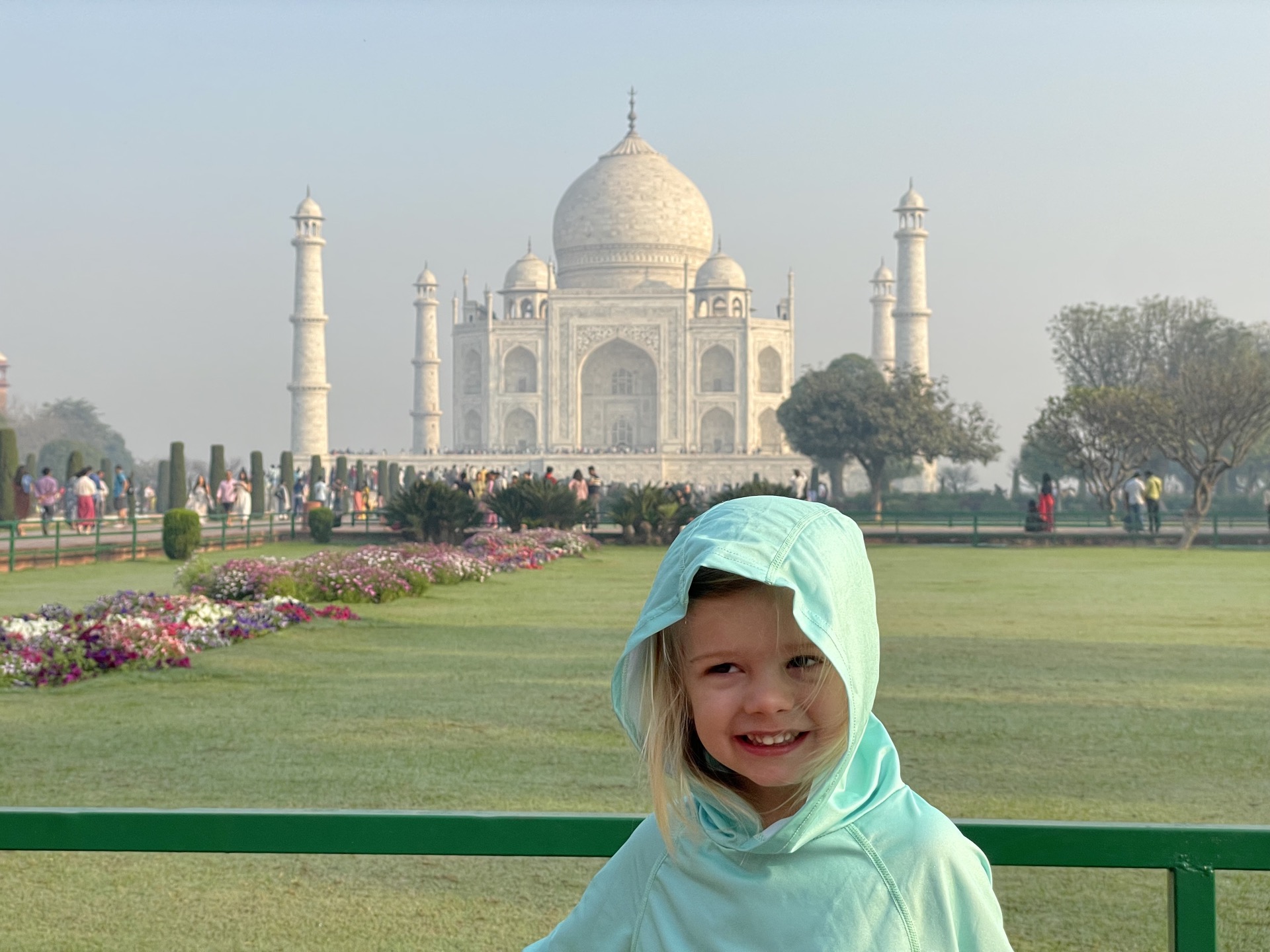
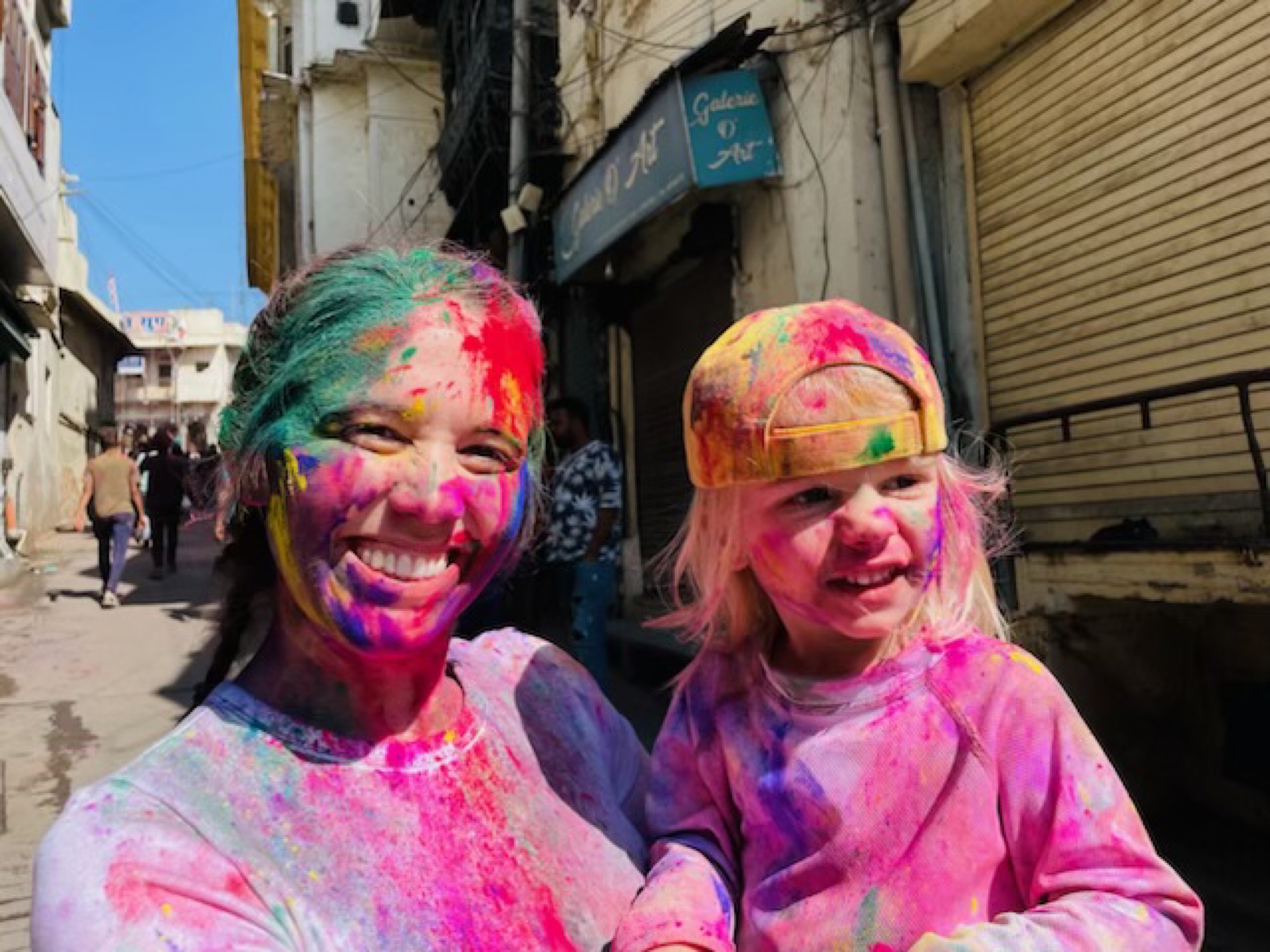
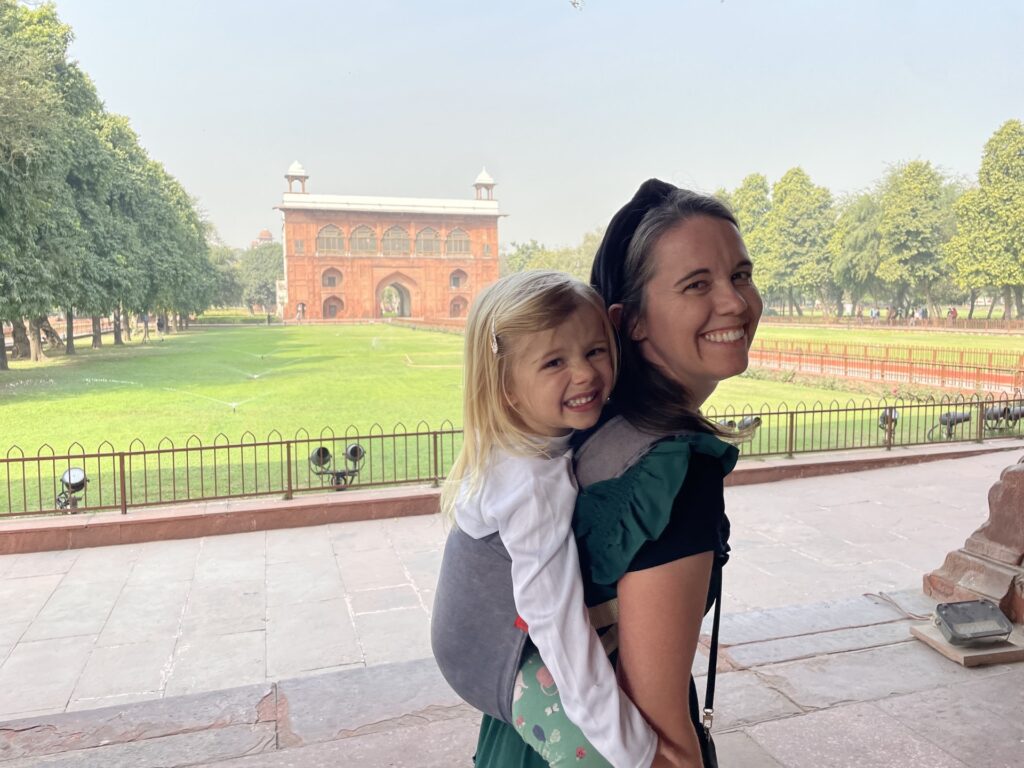
Part 3: Review and Reflection
Well, we did it. We went to India for two weeks with a two year old. I remember boarding our flight out of Delhi and thinking to myself, “Wow. I’m glad we did that, but I’m also kind of really glad it’s over.” I’ve since had a few months to look back on the experience … and to hear my toddler talk about it over and over … and I finally took the time to put some words to our feelings.
If you don’t want to read an extra 1,000 words on the matter, the short version is that it was hard, but I’m glad we did it, and I would definitely go back to India again.
Toddler Review of India
Me: Did you go to India?
Zoe: Yeah!
Me: What did you do there?
Zoe: H
I’ve had similar conversations with Zoe a hundred times before, during and after our trip. They used to always tell me they were excited to see the Taj Mahal, because there’s a photo of it in their favorite book. Now they tell me about playing Holi, riding a tuk tuk, and the giraffe they got at the Red Fort. Sometimes they talk about a specific floatie they used at a hotel pool or the flavor of chips they ate on the steps outside Jagdish Temple.
Whatever their response, it’s always one of many positive experiences they had in India. They never mention waking up early to board the train or that they didn’t eat fresh fruit for two whole weeks (woops!). They’ll never tell you that the pool water was actually freezing or that they were hangry before they got that snack in Udaipur.

This isn’t unique to bringing a child to India. That’s just how kids are no matter where they are or where they go. Children will find the joy, they will cling to the tiny things that are big things to them, and they will quickly adapt to the world around them.
So much about India was different than home. The way the buildings looked, the type of vehicles on the roads, the clothes people wore and the langue they spoke was all new to them. But going to India wasn’t the first time Zoe walked into a new place.
Where as my travel motto is “Same, same, but different,” Zoe’s entire life motto is “Different, Different, but the same.” Kids are constantly experiencing new things. They just started day care and that was different, but turned out fun. They moved to a new home in a new city and that was different, but turned out fun. So when Zoe arrived in India, they did what they always do. They found the fun.

The fun Zoe found was not always the things that were unique to India — they loved the pools and the toys and the playgrounds, which you could find anywhere — but some of it was. They got to play Holi and celebrate an Indian festival with other Indian kids in India! They got to ride in a tuk tuk and a rickshaw and drive a boat, which they would have never been able to do in NYC. To them it was just dancing and running around, but the the backdrop was the Taj Mahal.
Zoe remembers this trip vividly right now, but they might not remember everything forever. And that’s okay! Honestly, my husband won’t either! Lifetimes memories don’t have to be the only reason we travel. India was a unique, joyful, colorful experience. Our toddler had so much fun, found so much joy, and lived those moments to the fullest. That is why we travel, and that is why we went to India.
Parent Review of India
Taking a toddler to India was hard, but that’s because India is hard. It’s a huge country, so planning cities, transportation and activities took time. Food safety was really hard and we had to constantly be cautious about what we ate and drank. Even just getting around cities was hard because we couldn’t walk or take the Metro as much as we’re used to.
That fact that we had a toddler didn’t actually make things much harder. The hard parts about having a 2-year-old — feeding them, entertaining them, putting them to bed — are all the same no matter where we are. The only thing that was different with a toddler was that we had to hire drivers more so they could safely ride in their car seat. If anything, this made the experience easier.
I was also worried about my kid having a good time. They’re pretty shy and don’t like loud noises, so I was concerned they would be completely overwhelmed. It did take them a bit of time to warm up to strangers talking to them and Holi was definitely scary at first, but I was thrilled to see that they actually loved being in India so much more than I expected.
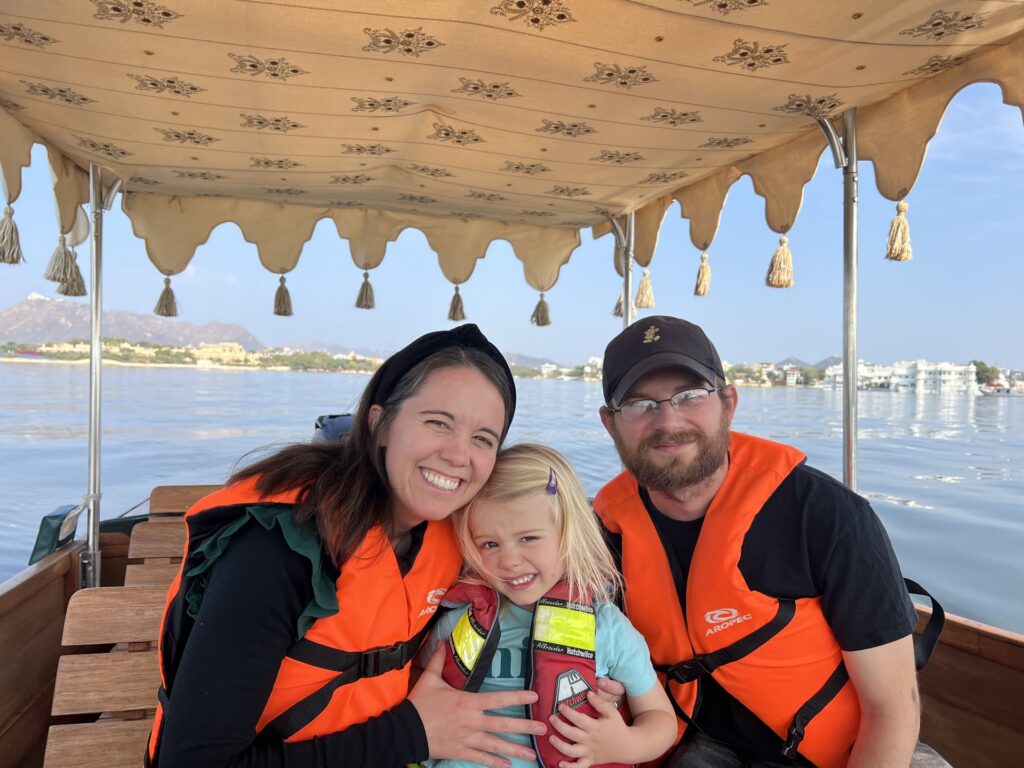
As you surely noticed in reading this post, we took the luxury approach to this trip. As an adult traveler looking back, in may ways this approach made the trip a bit sterile. It was probably less “authentic,” we didn’t have any kooky fun travel stories, and we definitely ate less local cuisine. But as a parent, I stand by the decision.
We learned pretty quick that our child would do just about anything in the morning if they knew they could swim in the pool in the afternoon. That was a trade we were willing to make. It also turns out that we also really needed a break midday, too. Our busy mornings were physically exhausting for our toddler, but they were emotionally exhausting for us.
India will open your eyes and break your heart in many ways, but particularly as a parent. I watched children take baths in the street and sleep outside of train stations, most all of them were barefoot. To see that and then take your child back to The Oberoi where they’ll get a free macaron just for walking in the door is a real reminder of our intense privilege and fortune. That’s a feeling I was never able to come to terms with.
India was hard, but I would absolutely go back. Even as I was actively dreading upcoming parts of our trip (hello, overnight train), I was adding to my list of places I wanted to go next. India has a complexity, vastness and diverseness to it that I was constantly in awe of. I also just loved how strangers treated my child in India. I loved the massive and beautiful tombs as much as the tiny shrines hidden around every corner. Even the traffic and the decorations on the semi trucks made the list of things I loved.
Finding joy in the little things and the unexpected things is definitely something I learned from my toddler. And that’s why trips like this are worth it.
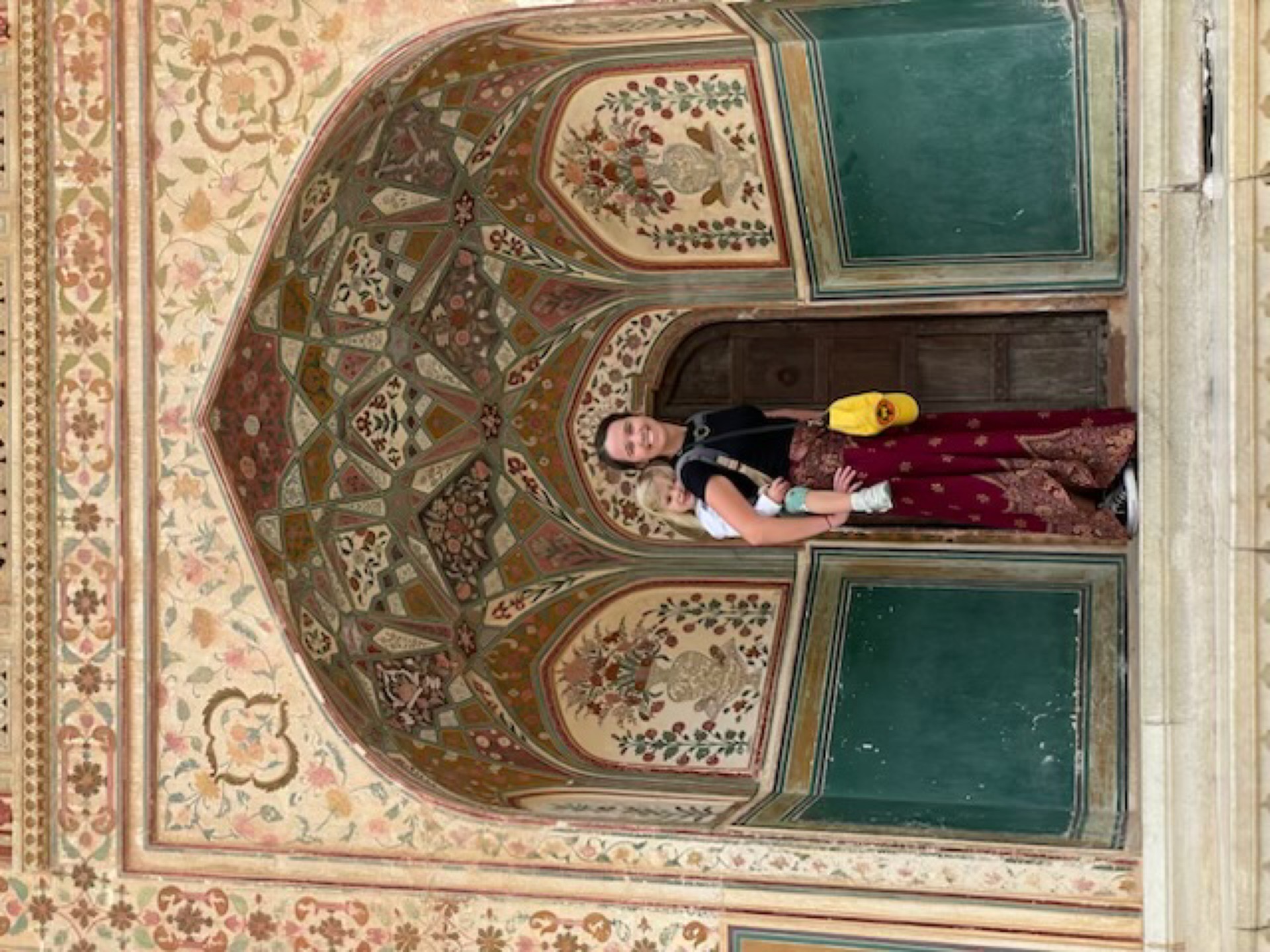
Tips for Going to India with Kids
- Read books about India before you go. I didn’t expect this to work as well as it did, but it really got our kid excited about India. They recognized things from their books and were excited to visit them! And now when we read those books, they’re so excited to tell us “I been there!” (We reccomend Tiny Travelers India Treasure Quest and Good Night India.)
- Watch YouTube videos. Similar to reading books, watching videos about the specific places you’re going and things you are doing will help prepare your child and get them excited.
- Choose your hotel wisely. I’d highly recommend a hotel that has a pool and restaurant(s) on property. If you need a crib, be sure to confirm that they have one before you book.
- Talk to your kids about photo requests. It’s really common in India and Asia for strangers to ask for photos with foreigners, especially white and/or blonde Westerners. Be sure to explain this to your child and decide as a family (or as parents) how you want to handle that. You may choose to say no or you may leave the decision up to your child. Either way, they should be prepared for it.
- Stay away from stray dogs. There are a lot of stray dogs in India. If your kid is anything like ours, they will want to pet all of them. In our experience, these dogs were not at all aggressive and never approached us if we gave them space. Just keep an eye on your child when dogs are around so they don’t try to sneak in a pet. You want to avoid this as rabies is a concern in India.
- Don’t drink the water. It’s easy to remember to not drink water from the faucet, but it’s harder to remember all the sneaky ways you’re exposed to tap water. Avoid ice, produce washed in tap water, and even utensils cleaned with tap water. We’d also recommend brushing your teeth with bottled water, which is surprisingly hard to remember to do.
- Submit your Visa request ASAP. Travelers from most countries will need an eVisa prior to landing in India. It is a relatively easy process, but it can take time. We had some issues with ours and it took a few weeks to come through. Don’t wait till the last minute on this.
- Don’t fill your suitcase with diapers. We almost never pack enough diapers for our entire trip. Babies all over the world wear diapers, so you can you almost always stock up at your destination. We ran out of diapers in Agra so we asked our hotel where to go to buy more. They actually went out, got diapers for us, and delivered them to our room that day! (I’m sure we were overcharged for it, but I gotta say it was worth it.)
- Go to sites early. Try to get to major attractions as soon as they open. Morning times are cooler and much less crowded. This matters at some places more than others, but it’s most important at the City Palace in Jaipur and of course the Taj Mahal.
- Push your child out of their comfort zone. When we first got to Jagdish Temple on Holi, our toddler was terrified. It was loud and crowded and people were getting Mommy dirty. They wanted to go home. It was hard, but we encouraged them to stay. We showed them that the colors were fun and let them play with other kids who were getting dirty, too. Half an hour later, they were having the time of their life and wanted to stay and play Holi forever! It was hard for all of us but so worth it in the end.
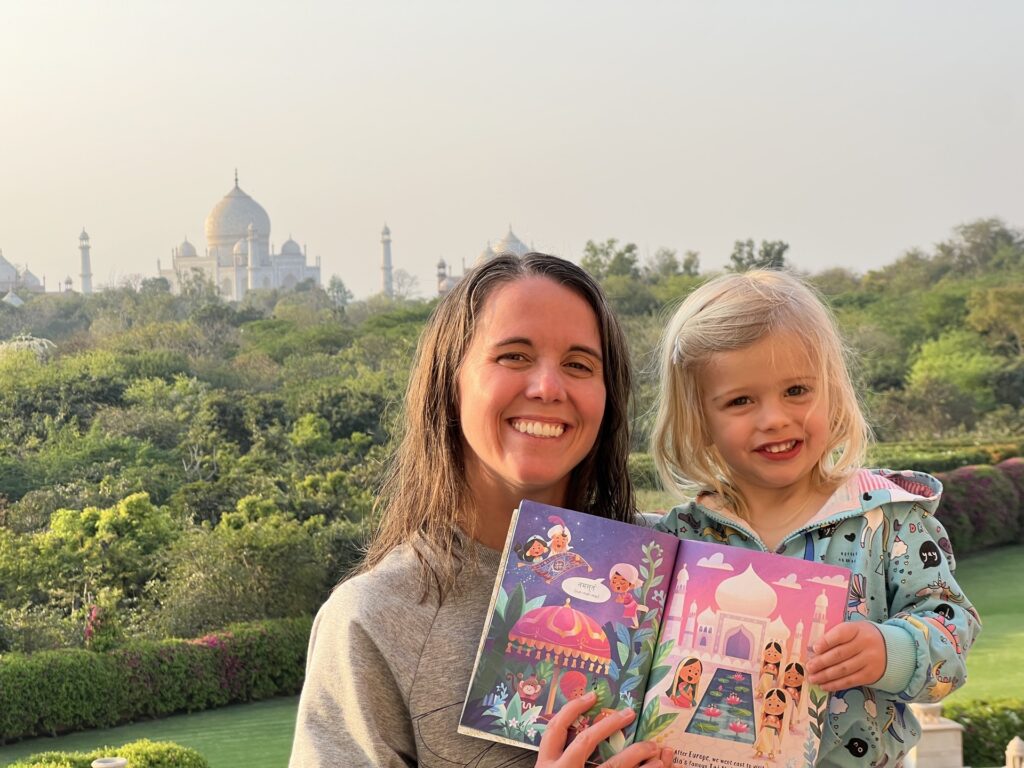
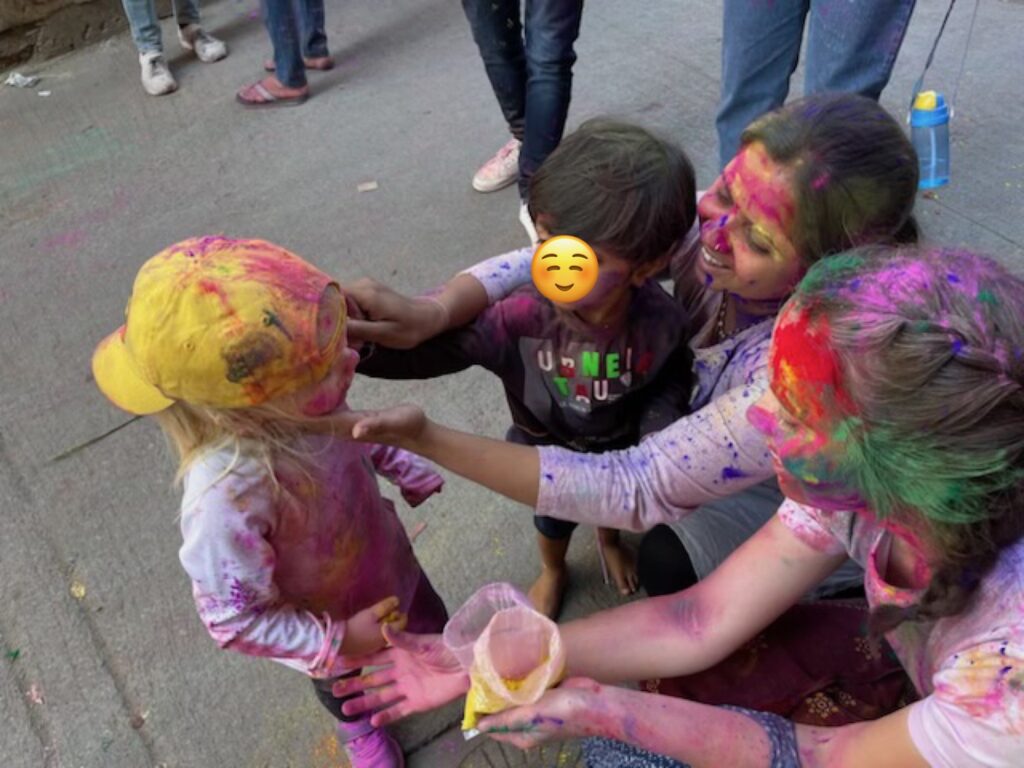
More From This Trip
- Emirates Business Class Review – A380 JFK to DXB
- Our Stay at Atlantis Dubai – A Perfect Place to Recharge
- Detailed 2-Day Dubai Itinerary
- Air India Business Class Review – 787 from DXB to DEL
- A Parent’s Guide to Traveling to India with Kids
- India Golden Triangle in 10 Days [Travel Guide, Itinerary &Tips]
- 3 Days in Delhi – Sample Itinerary + Planning Guide
- The Oberoi New Delhi Hotel Review
- Jaipur Itinerary – 1 or 2 Days in the Pink City
- Review of Jai Mahal Palace (Jaipur)
- Train from Jaipur to Udaipur – AC 3-Tier Sleeper Class
- The Oberoi Udaivilas Hotel Review (Udaipur)
- Udaipur Travel Guide + Things To Do
- Celebrating Holi in Udaipur (With a Kid)
- Overnight Train from Udaipur to Agra – AC First Class Sleeper
- The Oberoi Amarvilas Review: A Luxury Hotel with Taj Mahal Views
- Kerala Express Review – Agra to Delhi in AC 2-Tier Sleeper Class
- Hotel Review: JW Marriott New Delhi Aerocity
- Qatar Airways Economy Review – DEL to DOH
- Doha Things To Do & Travel Guide (Perfect for a Stopover!)
- Qatar Airways Qsuite Review – 777 from DOH to JFK
